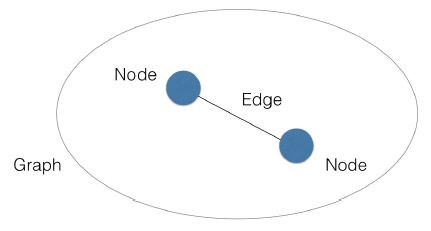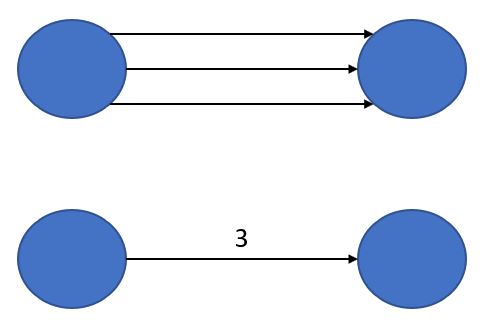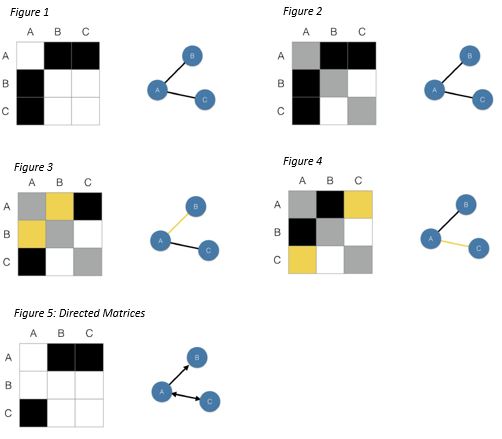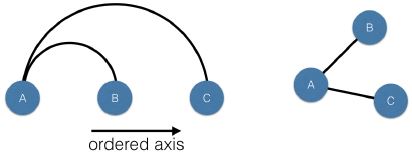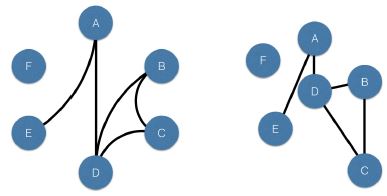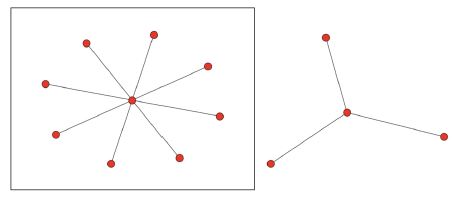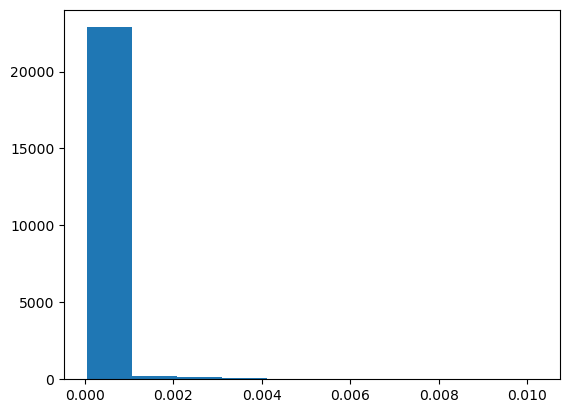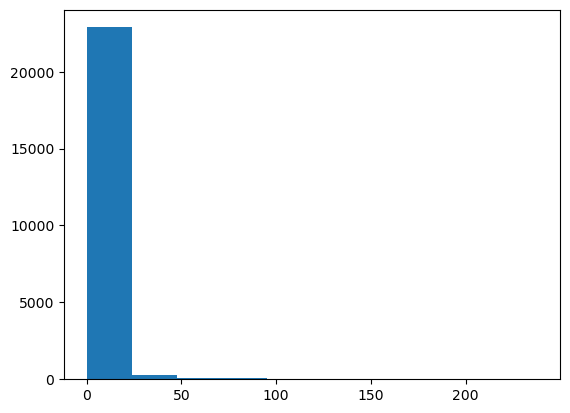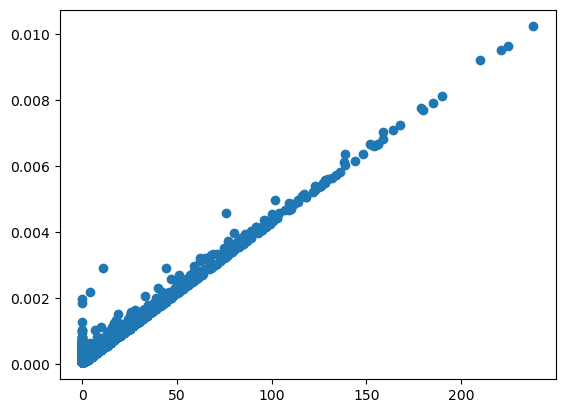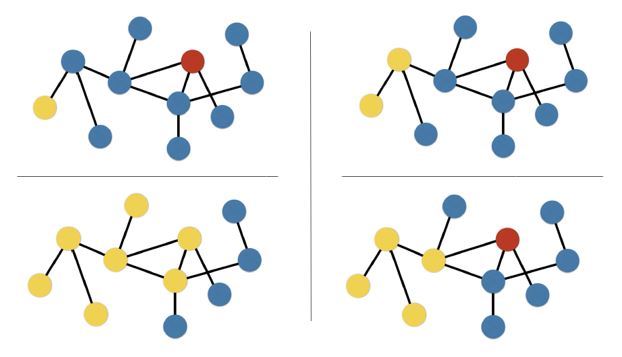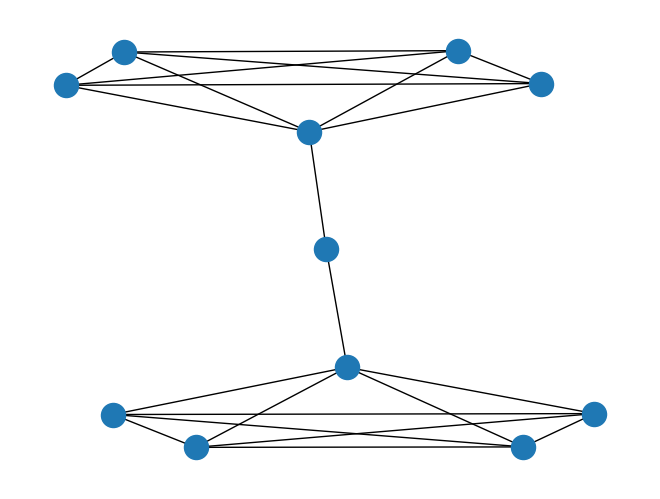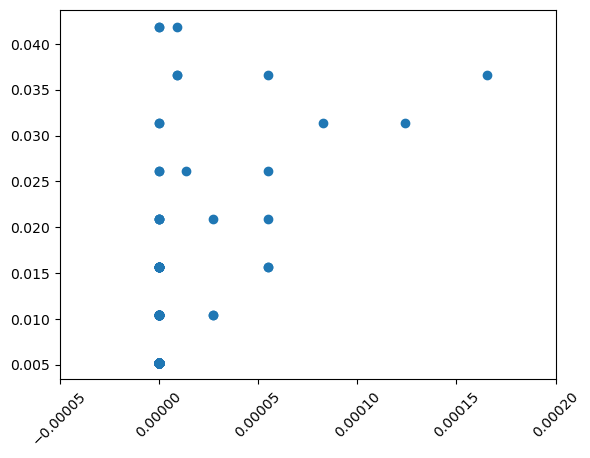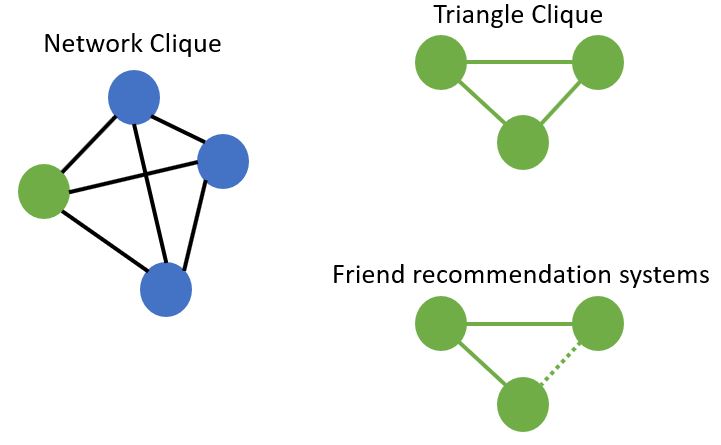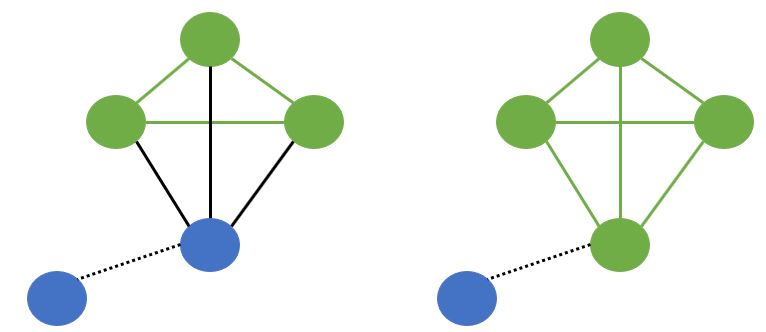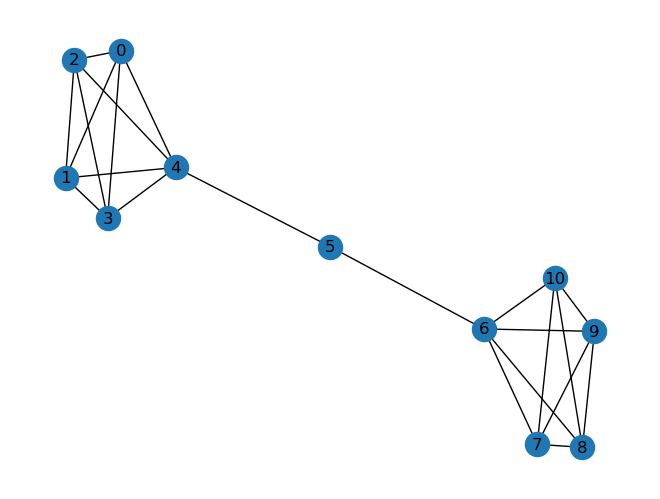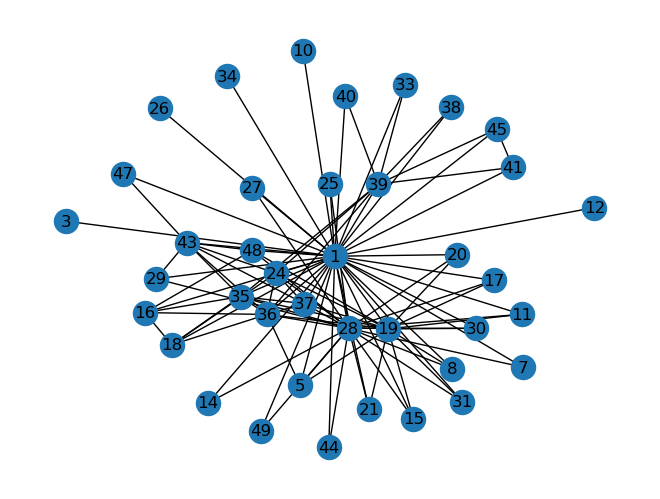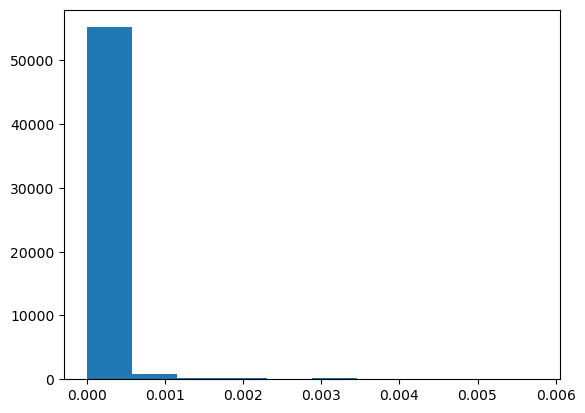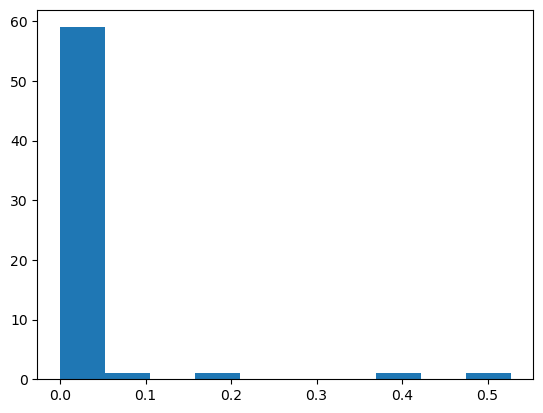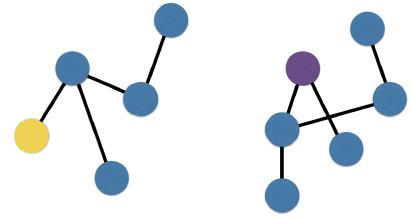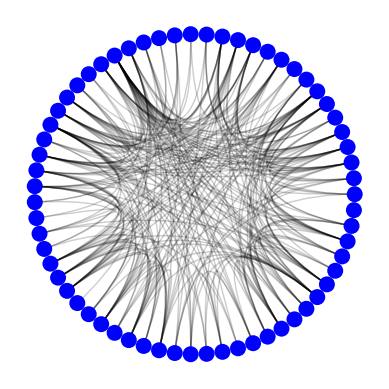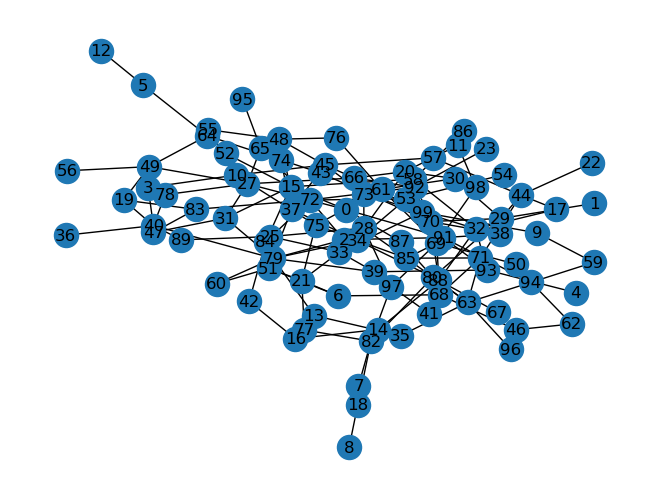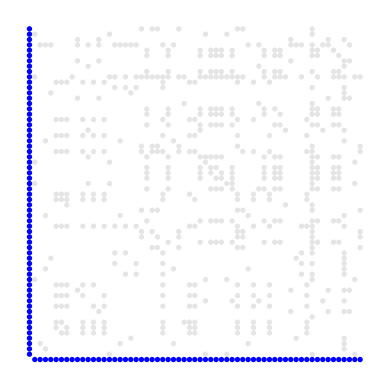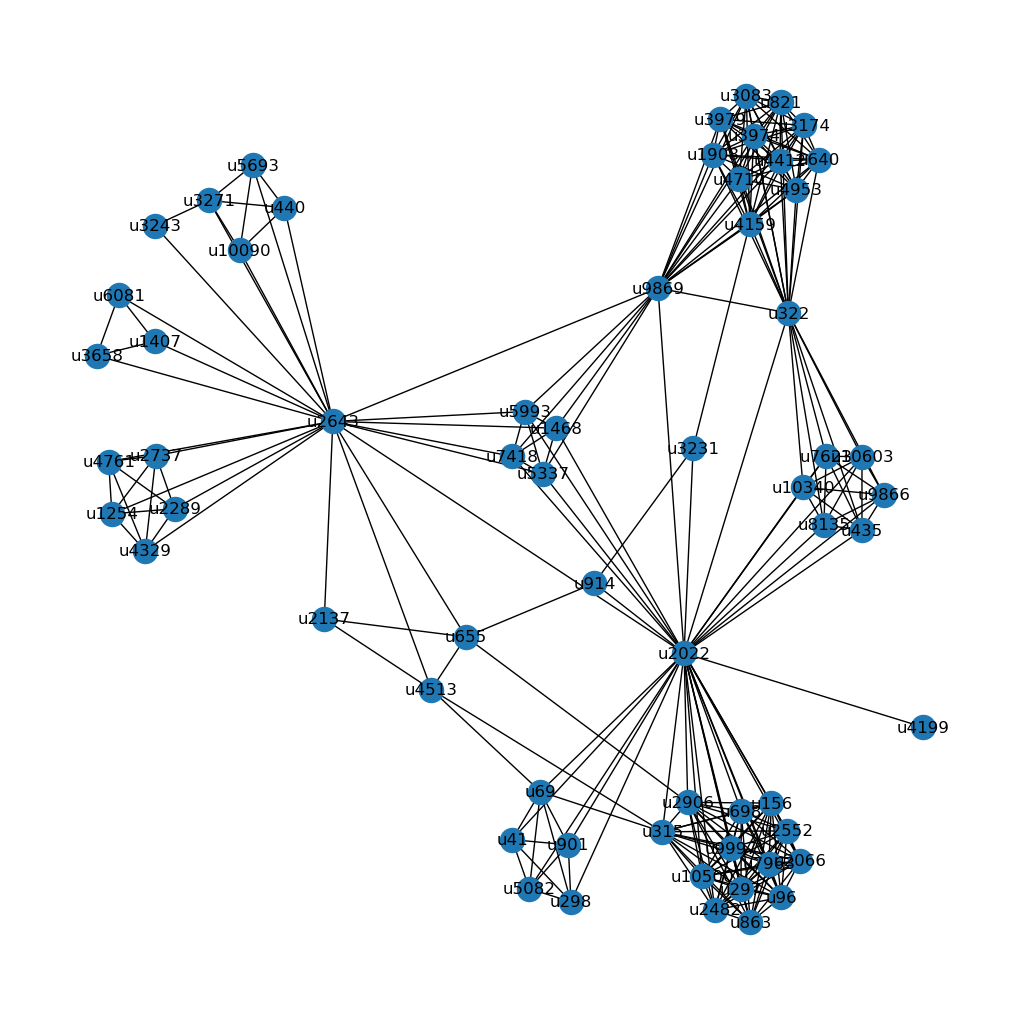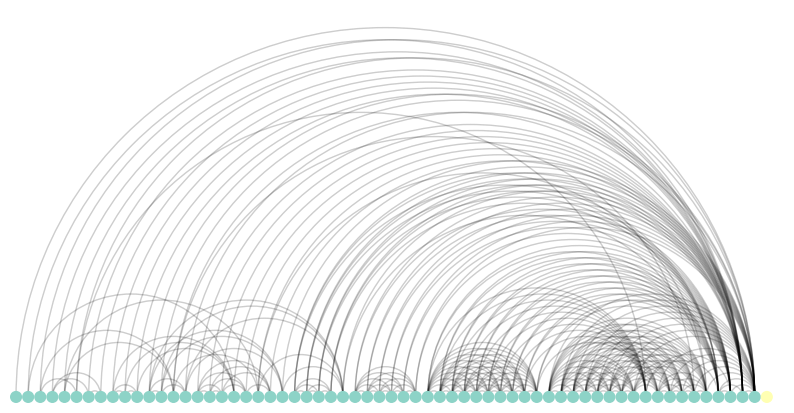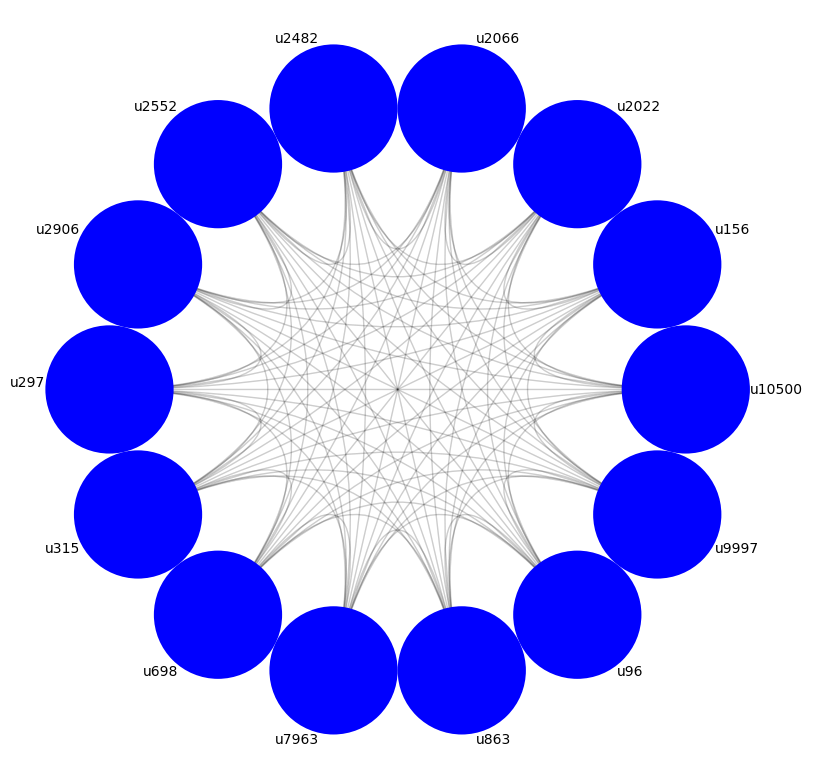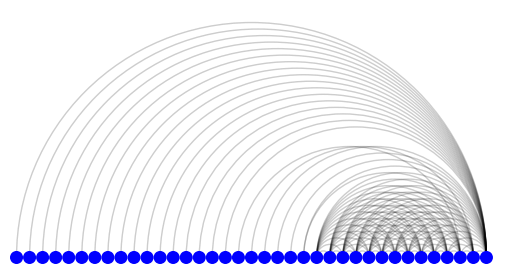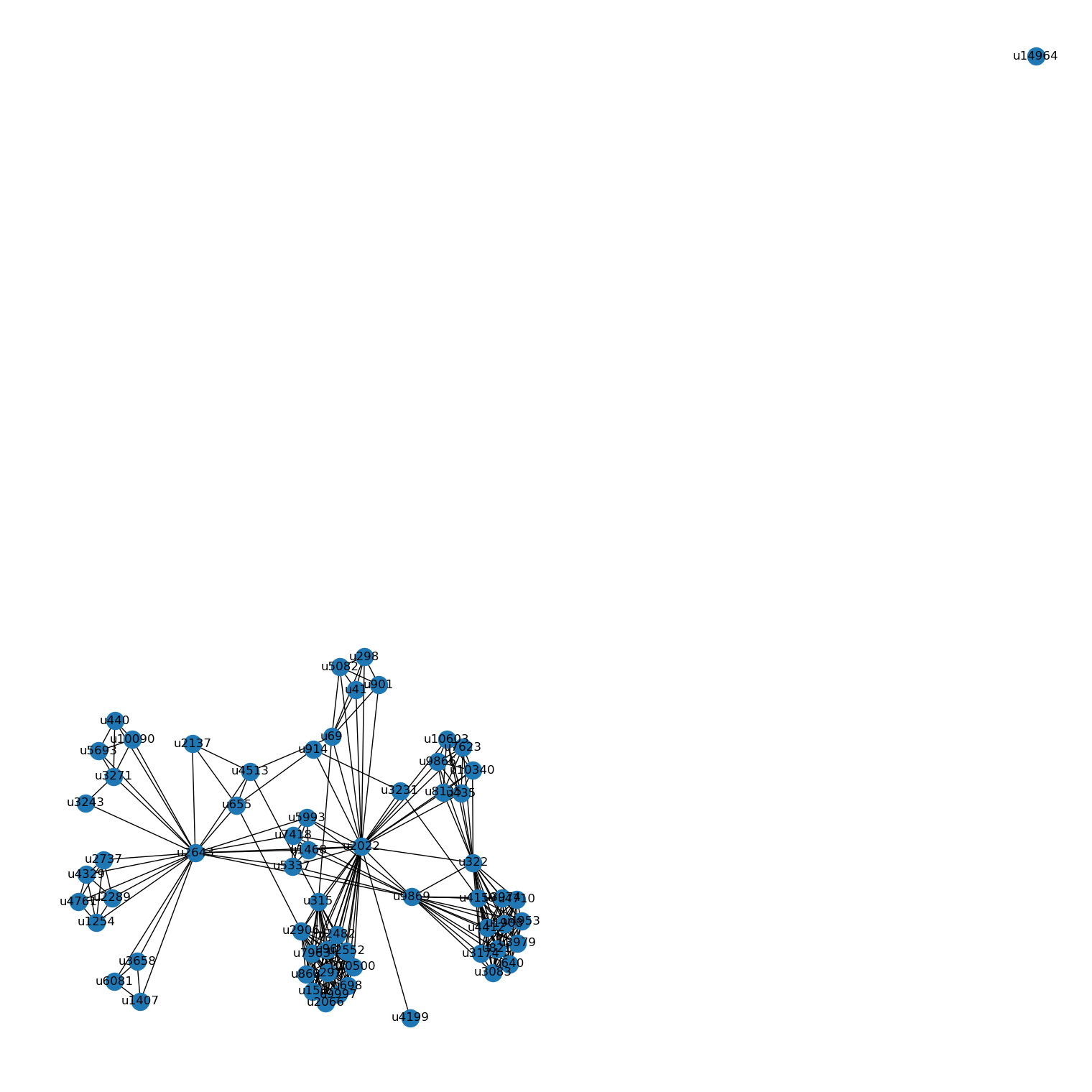Introduction to Network Analysis in Python
- Course: DataCamp: Introduction to Network Analysis in Python
- This notebook was created as a reproducible reference.
- The material is from the course
- I completed the exercises
- If you find the content beneficial, consider a DataCamp Subscription.
- I added a function (
create_dir_save_file) to automatically download and save the required data (data/2020-05-21_intro_to_network_analysis_in_python) and image (Images/2020-05-21_intro_to_network_analysis_in_python) files.
Course Description
From on-line social networks such as Facebook and Twitter to transportation networks such as bike sharing systems, networks are everywhere. And knowing how to analyze them will open up a new world of possibilities for you as a data scientist. This course will equip you with the skills to analyze, visualize, and make sense of networks. You’ll apply the concepts you learn to real-world network data using the powerful NetworkX library. With the knowledge gained in this course, you’ll develop your network thinking skills and be able to look at your data with a fresh perspective.
Note
There have been significant changes to nxviz v0.7.4. The code in the notebook has been update to use the new function calls, but the original instructions have not been altered.
Imports
1
2
3
4
5
6
7
8
9
10
11
12
13
from pathlib import Path
import requests
import networkx as nx
import nxviz as nv # using v0.7.4
from nxviz import annotate
import matplotlib as mpl
import matplotlib.pyplot as plt
from datetime import datetime, date
from pprint import pprint as pp
from itertools import combinations
import random
from collections import Counter, defaultdict
import pickle
1
2
3
4
5
6
7
8
9
10
11
12
C:\Users\trenton\anaconda3\Lib\site-packages\nxviz\__init__.py:18: UserWarning:
nxviz has a new API! Version 0.7.4 onwards, the old class-based API is being
deprecated in favour of a new API focused on advancing a grammar of network
graphics. If your plotting code depends on the old API, please consider
pinning nxviz at version 0.7.4, as the new API will break your old code.
To check out the new API, please head over to the docs at
https://ericmjl.github.io/nxviz/ to learn more. We hope you enjoy using it!
(This deprecation message will go away in version 1.0.)
warnings.warn(
1
2
print(f'NetworkX version: {nx.__version__}')
print(f'Matplotlib version: {mpl.__version__}')
1
2
NetworkX version: 3.1
Matplotlib version: 3.8.0
Functions
1
2
3
4
5
6
7
8
9
10
11
12
13
14
15
16
17
def create_dir_save_file(dir_path: Path, url: str):
"""
Check if the path exists and create it if it does not.
Check if the file exists and download it if it does not.
"""
if not dir_path.parents[0].exists():
dir_path.parents[0].mkdir(parents=True)
print(f'Directory Created: {dir_path.parents[0]}')
else:
print('Directory Exists')
if not dir_path.exists():
r = requests.get(url, allow_redirects=True)
open(dir_path, 'wb').write(r.content)
print(f'File Created: {dir_path.name}')
else:
print('File Exists')
1
2
data_dir = Path('data/2020-05-21_intro_to_network_analysis_in_python')
images_dir = Path('Images/2020-05-21_intro_to_network_analysis_in_python')
Datasets
1
2
twitter = 'https://assets.datacamp.com/production/repositories/580/datasets/64cf6963a7e8005e3771ef3b256812a5797320f0/ego-twitter.p'
github = 'https://assets.datacamp.com/production/repositories/580/datasets/69ada08d5cce7f35f38ffefe8f2291b7cfcd6000/github_users.p'
1
2
3
4
5
6
7
8
datasets = [twitter, github]
data_paths = list()
for data in datasets:
file_name = data.split('/')[-1].replace('?raw=true', '')
data_path = data_dir / file_name
create_dir_save_file(data_path, data)
data_paths.append(data_path)
1
2
3
4
Directory Exists
File Exists
Directory Exists
File Exists
Data
1
2
3
# .read_gpickle is no longer available
# T = nx.read_gpickle(data_paths[0])
# Gh = nx.read_gpickle(data_paths[1])
1
2
3
4
5
with open(data_paths[0], 'rb') as f:
T = pickle.load(f)
with open(data_paths[1], 'rb') as f:
Gh = pickle.load(f)
Introduction to networks
In this chapter, you’ll be introduced to fundamental concepts in network analytics while exploring a real-world Twitter network dataset. You’ll also learn about NetworkX, a library that allows you to manipulate, analyze, and model graph data. You’ll learn about the different types of graphs and how to rationally visualize them.
Networks
Examples of Networks
- Social
- In a social network, we’re modeling the relationship between people.
- Transportation
- In a transportation network, we’re modeling the connectivity between locations, as determined by the roads or flight paths connection them.
- Networks are a useful tool for modeling relationships between entities.
Insights
- Important entities: influencers in social networks
- Pathfinding: most efficient transportation path
- Clustering: finding communities
- By modeling the data as a network, you can gain insight into what entities (or nodes) are important, such as broadcasters or influencers in a social network.
- You can start to think about optimizing transportation between cities.
- Leverage the network structure to find communities in the network.
Network Structure
- Networks are described by two sets of items, which form a “network”.
- Nodes
- Edges
- In mathematical terms, this is a graph.
- Nodes and edges can have metadata associated with them.
- Lets say there are two friends, Hugo and myself, who met on May 21, 2016.
- The nodes may be “Hugo” and myself, with metadata stored in a
key-valuepair asidandage. - The friendship is represented as a line between two nodes, and may have metadata such as
date, which represents the date we first met.
NetworkX
- This python library allows us to manipulate, analyze, and model, graph data.
- Using
nx.Graph(), we initialize an empty graph, to which we can add nodes and edges - The integers 1, 2, and 3 can be entered as nodes, using the
add_nodes_frommethod, passing in the list[1, 2, 3], as an argument. - Use the
.nodesmethod to see the nodes present in the graph. - Similarly, use
.add_edgesand.edgesto add and see the edges present in the graph. - Edges between nodes are represented as a tuple, in which each tuple shows the nodes that are present on that edge.
1
2
3
4
5
6
7
8
9
import networkx as nx
G = nx.Graph()
G.add_nodes_from([1, 2, 3])
G.nodes()
>>> [1, 2, 3]
G.add_edge(1, 2)
G.edges()
>>> [(1, 2)]
- Metadata can be stored on the graph as well.
- For example, I can add to the node
1, alabelkey with the valueblue, just as I would assign a value to the key of a dictionary. - The node list can be retrieved with
G.nodes()and passing thedata=Trueparameter. - This returns a list of tuples, in which the first element of each tuple is the node, and the second element is a dictionary, in which the
key-valuepairs correspond to the metadata.
1
2
3
G.node[1]['label'] = 'blue'
G.nodes(data=True)
>>>[(1, {'label': 'blue}), (2, {}), (3, {})]
networkxas provides basic drawing functionality, using thenx.draw()function, which takes in a graphGas an argument.- In the IPyhton shell, you’ll also have to call
plt.show()function in order to display the graph screen. - With this graph, the
nx.draw()function will draw to screen what we call a node-link diagram rendering of the graph.
1
2
3
4
import matplotlib.pyplot as plt
nx.draw(G)
plt.show()
- The first set of exercises we’ll be doing is essentially exploratory data analysis on graphs.
Other Resources
What is a network?
Let’s think again about examples of networks. Which of the following data is least easily modeled as a network?
Airplane transportation.- Phone numbers in a telephone directory.
Co-authorship of papers.Atoms in a molecule.
- Compared to the other options, it would not be as easy to model phone numbers in a telephone directory as a network.
Basics of NetworkX API, using Twitter network
To get you up and running with the NetworkX API, we will run through some basic functions that let you query a Twitter network that has been pre-loaded for you and is available in the IPython Shell as T. The Twitter network comes from KONECT, and shows a snapshot of a subset of Twitter users. It is an anonymized Twitter network with metadata.
You’re now going to use the NetworkX API to explore some basic properties of the network, and are encouraged to experiment with the data in the IPython Shell.
Wait for the IPython shell to indicate that the graph that has been preloaded under the variable name T (representing a Twitter network), and then answer the following question:
What is the size of the graph T, the type of T.nodes(), and the data structure of the third element of the last edge listed in T.edges(data=True)? The len() and type() functions will be useful here. To access the last entry of T.edges(data=True), you can use list(T.edges(data=True))[-1].
- 23369,
networkx.classes.reportviews.NodeView,dict. 32369,tuple,datetime.23369,networkx.classes.reportviews.NodeView,datetime.22339,dict,dict.
1
2
3
4
print(len(T))
print(type(T.nodes()))
print(list(T.edges(data=True))[-1])
print(type(list(T.edges(data=True))[-1][2]))
1
2
3
4
23369
<class 'networkx.classes.reportviews.NodeView'>
(23324, 23336, {'date': datetime.date(2010, 9, 20)})
<class 'dict'>
Basic drawing of a network using NetworkX
NetworkX provides some basic drawing functionality that works for small graphs. We have selected a subset of nodes from the graph for you to practice using NetworkX’s drawing facilities. It has been pre-loaded as T_sub.
Instructions
- Import
matplotlib.pyplotaspltandnetworkxasnx. - Draw
T_subto the screen by using thenx.draw()function, and don’t forget to also useplt.show()to display it.
Creating T_sub
1
2
3
T_sub = nx.DiGraph()
edges_from_T = [x for x in T.edges(list(range(50)), data=True) if x[0] in [1, 16, 18, 19, 28, 36, 37, 39, 42, 43, 45] if x[1] < 50]
T_sub.add_edges_from(edges_from_T)
1
2
3
plt.figure(figsize=(8, 8))
nx.draw(T_sub, with_labels=True)
plt.show()
Queries on a graph
Now that you know some basic properties of the graph and have practiced using NetworkX’s drawing facilities to visualize components of it, it’s time to explore how you can query it for nodes and edges. Specifically, you’re going to look for “nodes of interest” and “edges of interest”. To achieve this, you’ll make use of the .nodes() and .edges() methods that Eric went over in the video. The .nodes() method returns a list of nodes, while the .edges() method returns a list of tuples, in which each tuple shows the nodes that are present on that edge. Recall that passing in the keyword argument data=True in these methods retrieves the corresponding metadata associated with the nodes and edges as well.
You’ll write list comprehensions to effectively build these queries in one line. For a refresher on list comprehensions, refer to Part 2 of DataCamp’s Python Data Science Toolbox course. Here’s the recipe for a list comprehension:
[ output expression for iterator variable in iterable if predicate expression ].
You have to fill in the _iterable_ and the _predicate expression_. Feel free to prototype your answer by exploring the graph in the IPython Shell before submitting your solution.
Instructions
- Use a list comprehension to get a list of nodes from the graph
Tthat have the'occupation'label of'scientist'. - The output expression
nhas been specified for you, along with the iterator variablesnandd. Your task is to fill in the iterable and the conditional expression. - Use the
.nodes()method ofTaccess its nodes, and be sure to specifydata=Trueto obtain the metadata for the nodes. - The iterator variable
dis a dictionary. The key of interest here is'occupation'and value of interest is'scientist'. - Use a list comprehension to get a list of edges from the graph T that were formed for at least 6 years, i.e., from before 1 Jan 2010.
- Your task once again is to fill in the iterable and conditional expression.
- Use the
.edges()method ofTto access its edges. Be sure to obtain the metadata for the edges as well. - The dates are stored as
datetime.dateobjects in the metadata dictionaryd, under the key'date'. To access the date 1 Jan 2009, for example, the dictionary value would bedate(2009, 1, 1).
1
2
3
4
5
# Use a list comprehension to get the nodes of interest: noi
noi = [n for n, d in T.nodes(data=True) if d['occupation'] == 'scientist']
# Use a list comprehension to get the edges of interest: eoi
eoi = [(u, v) for u, v, d in T.edges(data=True) if d['date'].year < 2010]
1
2
print(noi[:10])
print(eoi[:10])
1
2
[5, 9, 13, 15, 17, 19, 20, 22, 23, 27]
[(1, 5), (1, 9), (1, 13), (1, 15), (1, 16), (1, 17), (1, 18), (1, 19), (1, 24), (1, 27)]
Types of Graphs
- Undirected graphs
- They are comprised of edges that don’t have any inherent directionality associated with them.
- With Facebook, for example, when one user befriends another, the two are automatically connected with an edge.
- This is commonly drawn as a line with no arrows between two circles.
- Undirected graphs have the type
Graph
1
2
3
4
5
import networkx as nx
G = nx.Graph()
type(G)
>>> networkx.classes.graph.Graph
- Directed graphs
- This is because of the nature of how users interact with one another.
- For example, one user may follow another, but that other user may not follow back.
- As such, there’s an inherent directionality associated with the graph
- Directed grasphs have the type
DiGraph
1
2
3
D = nx.DiGraph()
type(D)
>>> networkx.classes.digraph.DiGraph
- Muti-edge (Directed) graphs
- Graph in which there are multiple edges permitted between the nodes
- For example, we may want to model trips between bike sharing stations
- Each trip may be one edge between the pair of stations
- Sometimes, for practical reasons, it may be too memory-intensive too model multiple edges per pair of nodes, and so one may choose to collapse the edges into a single edge that contains a metadata summary of the original.
- For example, we may want to collapse these three edges into a single one and give them a weight metadata with the value 3, indicating that it was originally 3 edges between the pair of nodes.
1
2
3
4
5
6
7
M = nx.MultiGraph
type(M)
>>> networkx.classes.multigraph.MultiGraph
MD = nx.MultiDiGraph
type(MD)
>>> networkx.classes.multidigraph.MultiDiGraph
- Self-loops
- Self-loops can be used in certain scenarios, such as in bike sharing data, where a trip begins at a station and ends at the same station.
Checking the un/directed status of a graph
In the video, Eric described to you different types of graphs. Which type of graph do you think the Twitter network data you have been working with corresponds to? Use Python’s built-in type() function in the IPython Shell to find out. The network, as before, has been pre-loaded as T.
Of the four below choices below, which one corresponds to the type of graph that T is?
Undirected Graph.- Directed Graph.
Undirected Multi-Edge Graph.Directed Multi-Edge Graph.
Specifying a weight on edges
Weights can be added to edges in a graph, typically indicating the “strength” of an edge. In NetworkX, the weight is indicated by the 'weight' key in the metadata dictionary.
Before attempting the exercise, use the IPython Shell to access the dictionary metadata of T and explore it, for instance by running the commands T.edges[1, 10] and then T.edges[10, 1]. Note how there’s only one field, and now you’re going to add another field, called 'weight'.
Instructions
- Set the
'weight'attribute of the edge between node1and10ofTto be equal to2. Refer to the following template to set an attribute of an edge:network_name.edges[node1, node2]['attribute'] = value. Here, the'attribute'is'weight'. - Set the weight of every edge involving node
293to be equal to1.1. To do this: - Using a
forloop, iterate over all the edges ofT, including themetadata. - If
293is involved in the list of nodes[u, v]:- Set the weight of the edge between
uandvto be1.1.
- Set the weight of the edge between
1
2
3
4
5
6
7
8
9
10
11
# Set the weight of the edge
T.edges[1, 10]['weight'] = 2
# Iterate over all the edges (with metadata)
for u, v, d in T.edges(data=True):
# Check if node 293 is involved
if 293 in [u, v]:
# Set the weight to 1.1
T.edges[u, v]['weight'] = 1.1
Checking whether there are self-loops in the graph
As Eric discussed, NetworkX also allows edges that begin and end on the same node; while this would be non-intuitive for a social network graph, it is useful to model data such as trip networks, in which individuals begin at one location and end in another.
It is useful to check for this before proceeding with further analyses, and NetworkX graphs provide a method for this purpose: .number_of_selfloops().
In this exercise as well as later ones, you’ll find the assert statement useful. An assert-ions checks whether the statement placed after it evaluates to True, otherwise it will throw an AssertionError.
To begin, use the .number_of_selfloops() method on T in the IPython Shell to get the number of edges that begin and end on the same node. A number of self-loops have been synthetically added to the graph. Your job in this exercise is to write a function that returns these edges.
Instructions
- Define a function called
find_selfloop_nodes()which takes one argument:G. - Using a
forloop, iterate over all the edges inG(excluding the metadata). - If node
uis equal to nodev:- Append
uto the listnodes_in_selfloops. - Return the list
nodes_in_selfloops.
- Append
- Check that the number of self loops in the graph equals the number of nodes in self loops. This has been done for you, so hit ‘Submit Answer’ to see the result!
1
2
3
4
5
6
7
8
9
10
11
12
13
14
15
16
17
18
19
20
21
# Define find_selfloop_nodes()
def find_selfloop_nodes(G):
"""
Finds all nodes that have self-loops in the graph G.
"""
nodes_in_selfloops = []
# Iterate over all the edges of G
for u, v in G.edges():
# Check if node u and node v are the same
if u == v:
# Append node u to nodes_in_selfloops
nodes_in_selfloops.append(u)
return nodes_in_selfloops
# Check whether number of self loops equals the number of nodes in self loops
# number_of_selfloops() is deprecated
assert len(list(nx.selfloop_edges(T))) == len(find_selfloop_nodes(T))
1
len(list(nx.selfloop_edges(T)))
1
42
There are 42 nodes in T that have self-loops.
Network Visualization
- Matrix plots
- Nodes are the rows and columns of a matrix, and cells are filled in according to whether an edge exists between the pairs of nodes.
- In an undirected graph, the matrix is symmetrical around the diagonal, which is highlighted in gray.
- Figure 3: edge (A, B) is equivalent to edge (B, A). Highlighted in yellow.
- Figure 4: edge (A, C) is equivalent to edge (C, A), because there’s no directionality associated with that edge.
- With directed graphs, the matrix representation is not necessarily going to be symmetrical.
- Figure 5: there’s a bidirectional edge between A and C, but only an edge from A to B and not B to A.
- (A, B) will be filled in, but not (B, A)
- If the nodes are ordered along the rows and columns, such that neighbors are listed close to one another, then a matrix plot can be used to visualized clusters, or communities, of nodes.
- Arc plots
- Are a transformation of the node-link diagram layout, in which nodes are ordered along one axis of the plot, and edges are drawn using circular arcs from one node to another.
- If the nodes are ordered according to some sortable rule, such as age in a social network of users, or otherwise grouped together, by geographic location in map for a transportation network, then it will be possible to visualized the relationship between connectivity and the sorted (or grouped) property.
- Arc plots are a good starting point for visualizing a network, as it forms the basis of the later plots that we’ll take a look at.
- Circos plots
- Are a transformation of the Arc Plot, such that two ends of the Arc Plot are joined together into a circle.
- Were originally designed for use in genomics, and you can think of them as an aesthetic and compact alternative to Arc Plots.
- You will be using nxviz to plot the graphs.
1
2
3
4
5
import nxviz as nv
import matplotlib.pyplot as plt
ap = nv.ArcPlot(G)
ap.draw()
plt.show()
Visualizing using Matrix plots
It is time to try your first “fancy” graph visualization method: a matrix plot. To do this, nxviz provides a MatrixPlot object.
nxviz is a package for visualizing graphs in a rational fashion. Under the hood, the MatrixPlot utilizes nx.to_numpy_matrix(G), which returns the matrix form of the graph. Here, each node is one column and one row, and an edge between the two nodes is indicated by the value 1. In doing so, however, only the weight metadata is preserved; all other metadata is lost, as you’ll verify using an assert statement.
A corresponding nx.from_numpy_matrix(A) allows one to quickly create a graph from a NumPy matrix. The default graph type is Graph(); if you want to make it a DiGraph(), that has to be specified using the create_using keyword argument, e.g. (nx.from_numpy_matrix(A, create_using=nx.DiGraph)).
One final note, matplotlib.pyplot and networkx have already been imported as plt and nx, respectively, and the graph T has been pre-loaded. For simplicity and speed, we have sub-sampled only 100 edges from the network.
Instructions
- Import
nxvizasnv. - Plot the graph
Tas a matrix plot. To do this: - Create the
MatrixPlotobject calledmusing thenv.MatrixPlot()function withTpassed in as an argument. - Draw the
mto the screen using the.draw()method. - Display the plot using
plt.show(). - Convert the graph to a matrix format, and then convert the graph back to the NetworkX form from the matrix as a directed graph.
- Check that the
categorymetadata field is lost from each node.
1
2
3
4
5
6
data = [(13829, 1386, {'date': date(2012, 3, 13)}), (3086, 669, {'date': date(2009, 3, 1)}), (3086, 3100, {'date': date(2013, 8, 10)}), (3086, 3117, {'date': date(2007, 12, 20)}), (4111, 4133, {'date': date(2007, 10, 28)}), (4111, 12582, {'date': date(2013, 6, 1)}), (6163, 7331, {'date': date(2013, 2, 3)}), (6163, 7336, {'date': date(2007, 9, 12)}), (6163, 6168, {'date': date(2008, 4, 2)}), (6163, 1326, {'date': date(2009, 2, 16)}), (4636, 4666, {'date': date(2012, 3, 20)}), (543, 12123, {'date': date(2014, 8, 12)}), (36, 24, {'date': date(2009, 4, 23)}), (12836, 12856, {'date': date(2014, 2, 21)}), (10790, 10854, {'date': date(2009, 8, 11)}), (9262, 9338, {'date': date(2007, 11, 11)}), (4160, 4161, {'date': date(2012, 4, 14)}), (4160, 3681, {'date': date(2013, 8, 10)}), (7746, 3396, {'date': date(2007, 2, 23)}), (7746, 543, {'date': date(2011, 7, 14)}), (7746, 5073, {'date': date(2012, 2, 25)}), (7746, 1130, {'date': date(2013, 8, 4)}), (7746, 3265, {'date': date(2008, 11, 8)}), (19013, 21248, {'date': date(2009, 3, 21)}), (19013, 21253, {'date': date(2007, 8, 17)}), (14916, 14930, {'date': date(2012, 4, 10)}), (5717, 5752, {'date': date(2009, 2, 2)}), (3159, 3176, {'date': date(2011, 8, 15)}), (3159, 3177, {'date': date(2008, 2, 1)}), (3159, 3193, {'date': date(2014, 1, 2)}), (1627, 1648, {'date': date(2011, 11, 7)}), (19550, 19570, {'date': date(2009, 11, 13)}), (5215, 5217, {'date': date(2011, 1, 7)}), (4198, 16203, {'date': date(2014, 12, 1)}), (3177, 3159, {'date': date(2010, 6, 2)}), (3177, 3176, {'date': date(2014, 11, 10)}), (1134, 2406, {'date': date(2011, 7, 10)}), (1134, 543, {'date': date(2011, 10, 20)}), (4206, 21962, {'date': date(2014, 4, 17)}), (6770, 2671, {'date': date(2010, 5, 18)}), (11384, 4955, {'date': date(2007, 2, 12)}), (11384, 2406, {'date': date(2007, 10, 13)}), (11384, 11402, {'date': date(2009, 11, 27)}), (10877, 10917, {'date': date(2014, 7, 17)}), (10877, 7886, {'date': date(2009, 1, 4)}), (10877, 36, {'date': date(2008, 10, 25)}), (10877, 10936, {'date': date(2008, 12, 26)}), (10877, 1326, {'date': date(2012, 1, 19)}), (10373, 1386, {'date': date(2011, 4, 21)}), (10373, 2501, {'date': date(2012, 8, 13)}), (3213, 3214, {'date': date(2008, 4, 19)}), (3213, 3265, {'date': date(2007, 8, 8)}), (3213, 3266, {'date': date(2009, 1, 4)}), (5626, 16654, {'date': date(2011, 3, 5)}), (20122, 20177, {'date': date(2014, 12, 21)}), (667, 669, {'date': date(2014, 2, 3)}), (667, 747, {'date': date(2008, 2, 23)}), (161, 18159, {'date': date(2014, 9, 22)}), (7331, 6163, {'date': date(2012, 10, 15)}), (7331, 6168, {'date': date(2012, 3, 17)}), (7331, 7606, {'date': date(2008, 11, 7)}), (7331, 24, {'date': date(2009, 9, 21)}), (7331, 36, {'date': date(2010, 5, 26)}), (10917, 10877, {'date': date(2011, 9, 7)}), (10917, 24, {'date': date(2014, 10, 16)}), (10917, 7886, {'date': date(2011, 7, 13)}), (10917, 36, {'date': date(2013, 8, 8)}), (10917, 1326, {'date': date(2009, 5, 23)}), (22184, 22188, {'date': date(2012, 11, 3)}), (6318, 6301, {'date': date(2011, 4, 3)}), (8367, 8421, {'date': date(2012, 7, 10)}), (21167, 3931, {'date': date(2012, 7, 9)}), (3265, 4955, {'date': date(2012, 6, 6)}), (3265, 4811, {'date': date(2014, 9, 18)}), (3265, 3266, {'date': date(2008, 9, 24)}), (3266, 4811, {'date': date(2007, 2, 16)}), (3266, 1926, {'date': date(2008, 3, 16)}), (3266, 3265, {'date': date(2014, 5, 25)}), (4291, 4306, {'date': date(2014, 9, 9)}), (4291, 4310, {'date': date(2007, 9, 11)}), (4811, 4955, {'date': date(2007, 4, 19)}), (4811, 3265, {'date': date(2013, 8, 23)}), (4811, 3266, {'date': date(2008, 8, 25)}), (7886, 10877, {'date': date(2012, 9, 5)}), (7886, 10917, {'date': date(2008, 9, 19)}), (7886, 24, {'date': date(2014, 8, 17)}), (7886, 36, {'date': date(2012, 9, 21)}), (7886, 1326, {'date': date(2012, 3, 23)}), (6863, 14981, {'date': date(2012, 8, 7)}), (13012, 13017, {'date': date(2012, 3, 4)}), (16597, 24, {'date': date(2012, 5, 2)}), (16597, 36, {'date': date(2011, 4, 19)}), (16597, 16610, {'date': date(2011, 11, 11)}), (12507, 12523, {'date': date(2012, 3, 11)}), (16618, 16619, {'date': date(2013, 3, 3)}), (13036, 15161, {'date': date(2012, 4, 23)}), (3826, 669, {'date': date(2014, 11, 9)}), (3826, 3100, {'date': date(2009, 2, 24)}), (3826, 3860, {'date': date(2013, 7, 27)}), (3826, 3681, {'date': date(2013, 2, 14)}), (7410, 7437, {'date': date(2012, 5, 2)}), (15092, 2148, {'date': date(2014, 11, 11)}), (15092, 20816, {'date': date(2009, 4, 8)}), (2820, 2826, {'date': date(2011, 10, 1)}), (2820, 2871, {'date': date(2010, 3, 26)}), (2311, 2371, {'date': date(2008, 8, 26)}), (11020, 11042, {'date': date(2008, 5, 12)}), (13070, 13079, {'date': date(2009, 10, 15)}), (20755, 24, {'date': date(2010, 11, 26)}), (20755, 1326, {'date': date(2014, 5, 2)}), (20756, 669, {'date': date(2012, 9, 7)}), (20756, 3100, {'date': date(2013, 3, 17)}), (20756, 3681, {'date': date(2010, 12, 9)}), (14613, 14617, {'date': date(2009, 6, 2)}), (10004, 10030, {'date': date(2008, 3, 1)}), (10004, 10111, {'date': date(2011, 7, 15)}), (4892, 1130, {'date': date(2011, 12, 10)}), (4892, 4947, {'date': date(2012, 3, 6)}), (2871, 15372, {'date': date(2014, 4, 27)}), (6968, 669, {'date': date(2010, 2, 6)}), (6968, 1386, {'date': date(2012, 9, 20)}), (6968, 4133, {'date': date(2012, 9, 22)}), (3385, 3396, {'date': date(2008, 3, 4)}), (8001, 23190, {'date': date(2008, 6, 26)}), (19787, 13581, {'date': date(2012, 4, 3)}), (21325, 21371, {'date': date(2009, 8, 2)}), (16720, 16734, {'date': date(2007, 10, 26)}), (16720, 16739, {'date': date(2008, 10, 24)}), (12119, 24, {'date': date(2013, 6, 1)}), (12119, 36, {'date': date(2007, 5, 1)}), (22872, 22918, {'date': date(2014, 7, 15)}), (7519, 16041, {'date': date(2012, 7, 8)}), (12640, 18082, {'date': date(2007, 4, 20)}), (12640, 18086, {'date': date(2008, 7, 8)}), (5987, 4957, {'date': date(2010, 12, 4)}), (5987, 492, {'date': date(2009, 6, 25)}), (19316, 19344, {'date': date(2013, 3, 15)}), (19316, 2501, {'date': date(2011, 11, 15)}), (13690, 4955, {'date': date(2014, 4, 5)}), (12162, 15560, {'date': date(2011, 1, 4)}), (2443, 3564, {'date': date(2014, 1, 9)}), (401, 492, {'date': date(2010, 11, 25)}), (401, 502, {'date': date(2013, 6, 27)}), (9106, 9107, {'date': date(2012, 5, 4)}), (8598, 8616, {'date': date(2011, 2, 6)}), (21919, 4161, {'date': date(2007, 7, 18)}), (21919, 669, {'date': date(2011, 12, 12)}), (21919, 3100, {'date': date(2012, 10, 15)}), (21919, 3681, {'date': date(2011, 1, 14)}), (10143, 4306, {'date': date(2009, 5, 26)}), (4517, 6414, {'date': date(2008, 7, 15)}), (20906, 2406, {'date': date(2012, 9, 5)}), (20906, 492, {'date': date(2013, 8, 12)}), (6059, 20368, {'date': date(2008, 11, 20)}), (2501, 1386, {'date': date(2009, 5, 1)}), (2501, 10373, {'date': date(2012, 7, 15)}), (13257, 13286, {'date': date(2008, 11, 4)}), (1484, 1492, {'date': date(2008, 6, 5)}), (1484, 1499, {'date': date(2013, 8, 9)}), (1996, 6038, {'date': date(2012, 7, 28)}), (20947, 669, {'date': date(2011, 7, 19)}), (20947, 3100, {'date': date(2010, 11, 23)}), (20947, 3681, {'date': date(2008, 6, 20)}), (5590, 5601, {'date': date(2012, 8, 17)}), (5590, 5626, {'date': date(2013, 8, 18)}), (18917, 19012, {'date': date(2013, 12, 15)}), (18917, 19013, {'date': date(2014, 1, 17)}), (10730, 24, {'date': date(2010, 1, 21)}), (10730, 36, {'date': date(2014, 1, 11)}), (10730, 1326, {'date': date(2008, 11, 4)}), (23024, 669, {'date': date(2010, 6, 15)}), (23024, 3100, {'date': date(2012, 6, 1)}), (23024, 23091, {'date': date(2011, 5, 20)}), (5109, 5112, {'date': date(2007, 5, 10)}), (13306, 13334, {'date': date(2014, 5, 18)})]
attr = {13829: {'category': 'D', 'occupation': 'celebrity'}, 15372: {'category': 'D', 'occupation': 'celebrity'}, 3086: {'category': 'P', 'occupation': 'scientist'}, 4111: {'category': 'D', 'occupation': 'scientist'}, 6163: {'category': 'P', 'occupation': 'scientist'}, 13334: {'category': 'P', 'occupation': 'scientist'}, 6168: {'category': 'P', 'occupation': 'celebrity'}, 24: {'category': 'P', 'occupation': 'politician'}, 3100: {'category': 'D', 'occupation': 'scientist'}, 4636: {'category': 'D', 'occupation': 'celebrity'}, 543: {'category': 'D', 'occupation': 'politician'}, 36: {'category': 'D', 'occupation': 'scientist'}, 12836: {'category': 'I', 'occupation': 'celebrity'}, 4133: {'category': 'D', 'occupation': 'scientist'}, 10790: {'category': 'D', 'occupation': 'scientist'}, 3117: {'category': 'P', 'occupation': 'politician'}, 9262: {'category': 'I', 'occupation': 'scientist'}, 23091: {'category': 'P', 'occupation': 'celebrity'}, 12856: {'category': 'D', 'occupation': 'politician'}, 4666: {'category': 'P', 'occupation': 'politician'}, 4160: {'category': 'P', 'occupation': 'politician'}, 4161: {'category': 'I', 'occupation': 'politician'}, 7746: {'category': 'P', 'occupation': 'scientist'}, 19012: {'category': 'D', 'occupation': 'politician'}, 19013: {'category': 'I', 'occupation': 'politician'}, 14916: {'category': 'I', 'occupation': 'politician'}, 14930: {'category': 'P', 'occupation': 'celebrity'}, 5717: {'category': 'P', 'occupation': 'politician'}, 3159: {'category': 'I', 'occupation': 'scientist'}, 1627: {'category': 'I', 'occupation': 'scientist'}, 19550: {'category': 'D', 'occupation': 'politician'}, 5215: {'category': 'P', 'occupation': 'politician'}, 5217: {'category': 'D', 'occupation': 'scientist'}, 3681: {'category': 'I', 'occupation': 'politician'}, 2148: {'category': 'D', 'occupation': 'politician'}, 4198: {'category': 'D', 'occupation': 'celebrity'}, 10854: {'category': 'D', 'occupation': 'politician'}, 3176: {'category': 'D', 'occupation': 'scientist'}, 3177: {'category': 'I', 'occupation': 'scientist'}, 1130: {'category': 'I', 'occupation': 'celebrity'}, 1134: {'category': 'P', 'occupation': 'scientist'}, 4206: {'category': 'I', 'occupation': 'scientist'}, 2671: {'category': 'P', 'occupation': 'scientist'}, 1648: {'category': 'P', 'occupation': 'politician'}, 19570: {'category': 'P', 'occupation': 'scientist'}, 6770: {'category': 'D', 'occupation': 'celebrity'}, 5752: {'category': 'D', 'occupation': 'scientist'}, 11384: {'category': 'D', 'occupation': 'politician'}, 3193: {'category': 'P', 'occupation': 'politician'}, 9338: {'category': 'I', 'occupation': 'politician'}, 10877: {'category': 'P', 'occupation': 'celebrity'}, 10373: {'category': 'I', 'occupation': 'politician'}, 14981: {'category': 'P', 'occupation': 'celebrity'}, 11402: {'category': 'I', 'occupation': 'politician'}, 3213: {'category': 'D', 'occupation': 'politician'}, 3214: {'category': 'P', 'occupation': 'celebrity'}, 5626: {'category': 'P', 'occupation': 'politician'}, 23190: {'category': 'P', 'occupation': 'celebrity'}, 20122: {'category': 'D', 'occupation': 'politician'}, 667: {'category': 'P', 'occupation': 'politician'}, 6301: {'category': 'I', 'occupation': 'scientist'}, 669: {'category': 'I', 'occupation': 'celebrity'}, 161: {'category': 'D', 'occupation': 'politician'}, 18082: {'category': 'I', 'occupation': 'celebrity'}, 7331: {'category': 'I', 'occupation': 'celebrity'}, 10917: {'category': 'P', 'occupation': 'scientist'}, 18086: {'category': 'D', 'occupation': 'scientist'}, 22184: {'category': 'P', 'occupation': 'scientist'}, 7336: {'category': 'D', 'occupation': 'scientist'}, 16041: {'category': 'P', 'occupation': 'scientist'}, 22188: {'category': 'I', 'occupation': 'scientist'}, 6318: {'category': 'P', 'occupation': 'politician'}, 8367: {'category': 'I', 'occupation': 'politician'}, 21167: {'category': 'D', 'occupation': 'celebrity'}, 10936: {'category': 'P', 'occupation': 'scientist'}, 3265: {'category': 'I', 'occupation': 'celebrity'}, 3266: {'category': 'P', 'occupation': 'politician'}, 4291: {'category': 'P', 'occupation': 'politician'}, 15560: {'category': 'P', 'occupation': 'celebrity'}, 4811: {'category': 'P', 'occupation': 'politician'}, 7886: {'category': 'P', 'occupation': 'politician'}, 6863: {'category': 'I', 'occupation': 'scientist'}, 20177: {'category': 'P', 'occupation': 'scientist'}, 4306: {'category': 'P', 'occupation': 'scientist'}, 13012: {'category': 'D', 'occupation': 'celebrity'}, 16597: {'category': 'P', 'occupation': 'celebrity'}, 4310: {'category': 'D', 'occupation': 'scientist'}, 13017: {'category': 'I', 'occupation': 'politician'}, 12507: {'category': 'I', 'occupation': 'politician'}, 16610: {'category': 'I', 'occupation': 'celebrity'}, 8421: {'category': 'I', 'occupation': 'politician'}, 16618: {'category': 'D', 'occupation': 'politician'}, 16619: {'category': 'I', 'occupation': 'celebrity'}, 13036: {'category': 'D', 'occupation': 'politician'}, 12523: {'category': 'P', 'occupation': 'politician'}, 747: {'category': 'D', 'occupation': 'politician'}, 18159: {'category': 'P', 'occupation': 'celebrity'}, 3826: {'category': 'P', 'occupation': 'politician'}, 7410: {'category': 'D', 'occupation': 'scientist'}, 15092: {'category': 'I', 'occupation': 'scientist'}, 21248: {'category': 'I', 'occupation': 'politician'}, 2820: {'category': 'I', 'occupation': 'celebrity'}, 21253: {'category': 'P', 'occupation': 'celebrity'}, 2311: {'category': 'I', 'occupation': 'politician'}, 2826: {'category': 'D', 'occupation': 'celebrity'}, 11020: {'category': 'D', 'occupation': 'politician'}, 7437: {'category': 'P', 'occupation': 'celebrity'}, 16654: {'category': 'I', 'occupation': 'scientist'}, 6414: {'category': 'D', 'occupation': 'scientist'}, 13070: {'category': 'I', 'occupation': 'politician'}, 13581: {'category': 'D', 'occupation': 'politician'}, 20755: {'category': 'D', 'occupation': 'celebrity'}, 20756: {'category': 'I', 'occupation': 'scientist'}, 14613: {'category': 'I', 'occupation': 'celebrity'}, 10004: {'category': 'I', 'occupation': 'politician'}, 3860: {'category': 'D', 'occupation': 'celebrity'}, 13079: {'category': 'D', 'occupation': 'celebrity'}, 14617: {'category': 'P', 'occupation': 'celebrity'}, 4892: {'category': 'P', 'occupation': 'celebrity'}, 11042: {'category': 'I', 'occupation': 'celebrity'}, 12582: {'category': 'P', 'occupation': 'politician'}, 1326: {'category': 'D', 'occupation': 'scientist'}, 10030: {'category': 'I', 'occupation': 'celebrity'}, 2871: {'category': 'P', 'occupation': 'scientist'}, 6968: {'category': 'P', 'occupation': 'celebrity'}, 3385: {'category': 'D', 'occupation': 'scientist'}, 15161: {'category': 'D', 'occupation': 'scientist'}, 8001: {'category': 'P', 'occupation': 'celebrity'}, 2371: {'category': 'D', 'occupation': 'scientist'}, 3396: {'category': 'P', 'occupation': 'scientist'}, 16203: {'category': 'D', 'occupation': 'politician'}, 19787: {'category': 'D', 'occupation': 'politician'}, 21325: {'category': 'P', 'occupation': 'scientist'}, 20816: {'category': 'I', 'occupation': 'scientist'}, 16720: {'category': 'I', 'occupation': 'scientist'}, 4947: {'category': 'I', 'occupation': 'celebrity'}, 12119: {'category': 'D', 'occupation': 'politician'}, 22872: {'category': 'I', 'occupation': 'politician'}, 12123: {'category': 'D', 'occupation': 'celebrity'}, 4955: {'category': 'P', 'occupation': 'celebrity'}, 4957: {'category': 'D', 'occupation': 'celebrity'}, 16734: {'category': 'D', 'occupation': 'politician'}, 7519: {'category': 'I', 'occupation': 'politician'}, 12640: {'category': 'P', 'occupation': 'celebrity'}, 3931: {'category': 'I', 'occupation': 'celebrity'}, 5987: {'category': 'D', 'occupation': 'scientist'}, 16739: {'category': 'I', 'occupation': 'celebrity'}, 2406: {'category': 'I', 'occupation': 'scientist'}, 1386: {'category': 'I', 'occupation': 'politician'}, 19316: {'category': 'I', 'occupation': 'politician'}, 13690: {'category': 'I', 'occupation': 'celebrity'}, 21371: {'category': 'P', 'occupation': 'scientist'}, 10111: {'category': 'I', 'occupation': 'celebrity'}, 12162: {'category': 'I', 'occupation': 'celebrity'}, 22918: {'category': 'I', 'occupation': 'celebrity'}, 1926: {'category': 'D', 'occupation': 'celebrity'}, 2443: {'category': 'I', 'occupation': 'scientist'}, 20368: {'category': 'I', 'occupation': 'politician'}, 19344: {'category': 'D', 'occupation': 'politician'}, 401: {'category': 'P', 'occupation': 'celebrity'}, 9106: {'category': 'P', 'occupation': 'scientist'}, 9107: {'category': 'D', 'occupation': 'celebrity'}, 6038: {'category': 'I', 'occupation': 'celebrity'}, 8598: {'category': 'P', 'occupation': 'politician'}, 21919: {'category': 'I', 'occupation': 'celebrity'}, 10143: {'category': 'P', 'occupation': 'celebrity'}, 4517: {'category': 'D', 'occupation': 'celebrity'}, 8616: {'category': 'D', 'occupation': 'celebrity'}, 20906: {'category': 'D', 'occupation': 'celebrity'}, 6059: {'category': 'D', 'occupation': 'scientist'}, 7606: {'category': 'P', 'occupation': 'scientist'}, 2501: {'category': 'P', 'occupation': 'scientist'}, 13257: {'category': 'D', 'occupation': 'celebrity'}, 21962: {'category': 'D', 'occupation': 'politician'}, 1484: {'category': 'I', 'occupation': 'politician'}, 1996: {'category': 'D', 'occupation': 'celebrity'}, 5073: {'category': 'P', 'occupation': 'celebrity'}, 20947: {'category': 'I', 'occupation': 'celebrity'}, 1492: {'category': 'D', 'occupation': 'celebrity'}, 5590: {'category': 'I', 'occupation': 'politician'}, 1499: {'category': 'P', 'occupation': 'celebrity'}, 5601: {'category': 'P', 'occupation': 'scientist'}, 18917: {'category': 'D', 'occupation': 'celebrity'}, 13286: {'category': 'I', 'occupation': 'scientist'}, 10730: {'category': 'D', 'occupation': 'celebrity'}, 492: {'category': 'I', 'occupation': 'politician'}, 3564: {'category': 'P', 'occupation': 'scientist'}, 23024: {'category': 'P', 'occupation': 'politician'}, 5109: {'category': 'I', 'occupation': 'politician'}, 502: {'category': 'P', 'occupation': 'scientist'}, 5112: {'category': 'I', 'occupation': 'celebrity'}, 13306: {'category': 'D', 'occupation': 'scientist'}}
t_131 = nx.DiGraph()
t_131.add_nodes_from(attr)
t_131.add_edges_from(data)
nx.set_node_attributes(t_131, attr)
1
2
3
# Create the MatrixPlot object: m
plt.figure(figsize=(10, 10))
m = nv.matrix(t_131)
1
2
3
4
5
6
7
8
9
# Convert T to a matrix format: A
A = nx.to_numpy_array(t_131)
# Convert A back to the NetworkX form as a directed graph: T_conv
T_conv = nx.from_numpy_array(A, create_using=nx.DiGraph())
# Check that the `category` metadata field is lost from each node
for n, d in T_conv.nodes(data=True):
assert 'category' not in d.keys()
Visualizing using Circos plots
Circos plots are a rational, non-cluttered way of visualizing graph data, in which nodes are ordered around the circumference in some fashion, and the edges are drawn within the circle that results, giving a beautiful as well as informative visualization about the structure of the network.
In this exercise, you’ll continue getting practice with the nxviz API, this time with the CircosPlot object. matplotlib.pyplot has been imported for you as plt.
Instructions
- Import
CircosPlotfromnxviz. - Plot the Twitter network
Tas a Circos plot without any styling. Use theCircosPlot()function to do this. Don’t forget to draw it to the screen using.draw()and then display it usingplt.show().
1
2
3
# Create the CircosPlot object: c
plt.figure(figsize=(10, 10))
ax = nv.circos(t_131)
Visualizing using Arc plots
Following on what you’ve learned about the nxviz API, now try making an ArcPlot of the network. Two keyword arguments that you will try here are node_order='keyX' and node_color='keyX', in which you specify a key in the node metadata dictionary to color and order the nodes by.
matplotlib.pyplot has been imported for you as plt.
Instructions
- Import
ArcPlotfromnxviz. - Create an un-customized ArcPlot of
T. To do this, use theArcPlot()function with justTas the argument. - Create another ArcPlot of
Tin which the nodes are ordered and colored by the'category'keyword. You’ll have to specify thenode_orderandnode_colorparameters to do this. For both plots, be sure to draw them to the screen and display them withplt.show().
1
2
3
# Create the un-customized ArcPlot object: a
plt.figure(figsize=(10, 10))
a = nv.arc(t_131)
1
2
3
# Create the customized ArcPlot object: a2
plt.figure(figsize=(10, 10))
ax = nv.arc(t_131, node_color_by='category', group_by='category')
Notice the node coloring in the customized ArcPlot compared to the uncustomized version. In the customized ArcPlot, the nodes in each of the categories - 'I', 'D', and 'P' - have their own color. If it’s difficult to see on your screen, you can expand the plot into a new window by clicking on the pop-out icon on the top-left next to ‘Plots’.
Important nodes
You’ll learn about ways to identify nodes that are important in a network. In doing so, you’ll be introduced to more advanced concepts in network analysis as well as the basics of path-finding algorithms. The chapter concludes with a deep dive into the Twitter network dataset which will reinforce the concepts you’ve learned, such as degree centrality and betweenness centrality.
Degree Centrality
- How to determine which nodes are important
- Which center node might be more important?
- The center node of the left graph is more important because it is connected to more nodes.
- Being connected to other nodes means other nodes are considered a neighbor of that node.
- From the concept of neighbors, we can now introduce the concept of degree centrality
- Degree centrality
- This is one of many metrics we can use to evaluate the importance of a node, and is simply defined as the number of neighbors that a node has divided by the total number of neighbors that the node could possible have: $\frac{\text{Number of Neighbors I Have}}{\text{Number of Neighbors I could Possibly Have}}$
- There are two scenarios possible here: - if self-loops are allowed, such as in a network mapping of all bike trips in a bike sharing system, then the number of neighbors that I could possibly have, is every single node in the graph, including myself. - if self-loops are not allowed, such as in the Twitter social network, where, by definition, my account cannot follow itself, the the number of neighbors I could possibly have is every other node in the graph, excluding myself.
- In real life, example of nodes in a graph that have high degree centrality might be: - Twitter broadcasters, that is, users that are followed by many other users - Airport transportation hubs, such as New York, London or Tokyo - Disease super-spreaders, who are the individuals that epidemiologists would want to track down to help stop the spread of a disease
- Betweenness centrality
Number of Neighbors
1
2
3
4
5
6
7
8
9
10
11
G.edges()
>>> [(1, 2), (1, 3), (1, 4), (1, 5), (1, 6), (1, 7), (1, 8), (1, 9)]
G.neighbors(1)
>>> [2, 3, 4, 5, 6, 7, 8, 9]
G.neighbors(8)
>>> [1]
G.neighbors(10)
>>> NetworkXError: The node 10 is not in the graph.
Degree Centrality
- self-loops are not considered
1
2
3
4
5
6
7
8
9
10
nx.degree_centrality(G)
>>> {1: 1.0,
2: 0.125,
3: 0.125,
4: 0.125,
5: 0.125,
6: 0.125,
7: 0.125,
8: 0.125,
9: 0.125}
Compute number of neighbors for each node
How do you evaluate whether a node is an important one or not? There are a few ways to do so, and here, you’re going to look at one metric: the number of neighbors that a node has.
Every NetworkX graph G exposes a .neighbors(n) method that returns a list of nodes that are the neighbors of the node n. To begin, use this method in the IPython Shell on the Twitter network T to get the neighbors of of node 1. This will get you familiar with how the function works. Then, your job in this exercise is to write a function that returns all nodes that have m neighbors.
Instructions
- Write a function called
nodes_with_m_nbrs()that has two parameters -Gandm- and returns all nodes that havemneighbors. To do this: - Iterate over all nodes in
G(not including the metadata). - Use the
len()andlist()functions together with the.neighbors()method to calculate the total number of neighbors that nodenin graphGhas.- If the number of neighbors of node
nis equal tom, addnto the setnodesusing the.add()method.
- If the number of neighbors of node
- After iterating over all the nodes in
G, return the setnodes. - Use your
nodes_with_m_nbrs()function to retrieve all the nodes that have 6 neighbors in the graphT.
1
2
3
4
5
6
7
8
9
10
11
12
13
14
15
16
17
18
19
20
21
22
# Define nodes_with_m_nbrs()
def nodes_with_m_nbrs(G, m):
"""
Returns all nodes in graph G that have m neighbors.
"""
nodes = set()
# Iterate over all nodes in G
for n in G.nodes():
# Check if the number of neighbors of n matches m
if len(list(G.neighbors(n))) == m:
# Add the node n to the set
nodes.add(n)
# Return the nodes with m neighbors
return nodes
# Compute and print all nodes in T that have 6 neighbors
six_nbrs = nodes_with_m_nbrs(T, 6)
print(six_nbrs)
1
{22533, 1803, 11276, 11279, 6161, 4261, 10149, 3880, 16681, 5420, 14898, 64, 14539, 6862, 20430, 9689, 475, 1374, 6112, 9186, 17762, 14956, 2927, 11764, 4725}
The number of neighbors a node has is one way to identify important nodes. It looks like 25 nodes in graph T have 6 neighbors.
Compute degree distribution
The number of neighbors that a node has is called its “degree”, and it’s possible to compute the degree distribution across the entire graph. In this exercise, your job is to compute the degree distribution across T.
Instructions
- Use a list comprehension along with the
.neighbors(n)method to get the degree of every node. The result should be a list of integers. - Use
nas your iterator variable. - The output expression of your list comprehension should be the number of neighbors that node
nhas - that is, its degree. Use thelen()andlist()functions together with the.neighbors()method to compute this. - The iterable in your list comprehension is all the nodes in
T, accessed using the.nodes()method. - Print the degrees.
1
2
degrees = [len(list(T.neighbors(n))) for n in T.nodes()]
degrees[:20]
1
[47, 0, 0, 0, 0, 0, 0, 0, 0, 0, 0, 0, 0, 0, 17, 0, 10, 27, 0, 0]
Degree centrality distribution
The degree of a node is the number of neighbors that it has. The degree centrality is the number of neighbors divided by all possible neighbors that it could have. Depending on whether self-loops are allowed, the set of possible neighbors a node could have could also include the node itself.
The nx.degree_centrality(G) function returns a dictionary, where the keys are the nodes and the values are their degree centrality values.
The degree distribution degrees you computed in the previous exercise using the list comprehension has been pre-loaded.
Instructions
- Compute the degree centrality of the Twitter network
T. - Using
plt.hist(), plot a histogram of the degree centrality distribution ofT. This can be accessed usinglist(deg_cent.values()). - Plot a histogram of the degree distribution
degreesofT. This is the same list you computed in the last exercise. - Create a scatter plot with
degreeson the x-axis and the degree centrality distributionlist(deg_cent.values())on the y-axis.
1
2
# Compute the degree centrality of the Twitter network: deg_cent
deg_cent = nx.degree_centrality(T)
1
2
3
4
5
6
7
8
9
10
11
12
13
14
# Plot a histogram of the degree centrality distribution of the graph.
plt.figure()
plt.hist(list(deg_cent.values()))
plt.show()
# Plot a histogram of the degree distribution of the graph
plt.figure()
plt.hist(degrees)
plt.show()
# Plot a scatter plot of the centrality distribution and the degree distribution
plt.figure()
plt.scatter(degrees, list(deg_cent.values()))
plt.show()
Given the similarities of their histograms, it should not surprise you to see a perfect correlation between the centrality distribution and the degree distribution.
Graph Algorithms
Finding Paths
- Pathfinding is important for:
- Optimization:
- finding the shortest transportation path between two nodes
- shortest transport paths
- Modeling:
- the spread of things
- disease spread
- information spread in a social network
- How do we find out if there’s a path between two nodes?
- If there’s a path, how do we find out what the shortest path is?
- Algorithm: Breadth-first search
- Developed in the 1950s as a way of finding the shortest path out of a maze.
- Given the following network comprised of 11 nodes, and we want to find the shortest path between the yellow and red nodes.
- If we start at the yellow node, we first ask for the yellow node’s neighbors.
- We then ask if the destination node is present in the set of yellow node’s neighbors
- If not, we continue on.
- Going out a 2nd degree of separation, we ask for the neighbors of our neighbors.
- The destination node is still not present, so we continue on.
- On our 3rd degree of separation out, we see that the destination node is present.
- At this point, we can stop and ignore the next degree of separation.
- Note there was one other path possible, but it was longer.
- As such, with the breadth-first search algorithm, we have achieved our goal of finding the shortest path between the pair of nodes.
- If we do
G.neighbors(1), we get back a list containing the nodes that are neighbors of1 - Let’s go one degree out, to the first node in the list of node
1’s neighbors, which is node10. - Let’s check the neighbors of
10: note that we have1, which is correct, and then19, and then a whole slew of other nodes. - Since
19, our destination node, is present in the neighbors of node10, we can stop there. - If
19wasn’t there, we would go on to check the neighbors of node5, which was the next node in the list of node1’s neighbors.
1
2
3
4
5
6
7
8
9
10
11
12
13
14
G
>>> <networkx.classes.graph.Graph at 0x10cc08828>
len(G.edges())
>>> 57
len(G.nodes())
>>> 20
list(G.neighbors(1))
>>> [10, 5, 14, 7]
list(G.neighborys(10))
>>> [1, 19, 5, 17, 8, 9, 13, 14]
- This was a manual check, but in the exercises, you’ll be implementing an automatic version of the breadth-first search algorithm.
Shortest Path I
You can leverage what you know about finding neighbors to try finding paths in a network. One algorithm for path-finding between two nodes is the “breadth-first search” (BFS) algorithm. In a BFS algorithm, you start from a particular node and iteratively search through its neighbors and neighbors’ neighbors until you find the destination node.
Pathfinding algorithms are important because they provide another way of assessing node importance; you’ll see this in a later exercise.
In this set of 3 exercises, you’re going to build up slowly to get to the final BFS algorithm. The problem has been broken into 3 parts that, if you complete in succession, will get you to a first pass implementation of the BFS algorithm.
Instructions
- Create a function called
path_exists()that has 3 parameters -G,node1, andnode2- and returns whether or not a path exists between the two nodes. - Initialize the queue of nodes to visit with the first node,
node1.queueshould be a list. - Iterate over the nodes in
queue. - Get the neighbors of the node using the
.neighbors()method of the graphG. - Check to see if the destination node
node2is in the set ofneighbors. If it is, returnTrue.
1
2
3
4
5
6
7
8
9
10
11
12
13
14
15
16
17
18
19
20
21
# Define path_exists()
def path_exists(G, node1, node2):
"""
This function checks whether a path exists between two nodes (node1, node2) in graph G.
"""
visited_nodes = set()
# Initialize the queue of nodes to visit with the first node: queue
queue = [node1]
# Iterate over the nodes in the queue
for node in queue:
# Get neighbors of the node
neighbors = G.neighbors(node)
# Check to see if the destination node is in the set of neighbors
if node2 in neighbors:
print('Path exists between nodes {0} and {1}'.format(node1, node2))
return True
break
Shortest Path II
Now that you’ve got the code for checking whether the destination node is present in neighbors, next up, you’re going to extend the same function to write the code for the condition where the destination node is not present in the neighbors.
All the code you need to write is in the else condition; that is, if node2 is not in neighbors.
Instructions
- Using the
.add()method, add the current nodenodeto the setvisited_nodesto keep track of what nodes have already been visited. - Add the neighbors of the current node
nodethat have not yet been visited toqueue. To do this, you’ll need to use the.extend()method ofqueuetogether with a list comprehension. The.extend()method appends all the items in a given list. - The output expression and iterator variable of the list comprehension are both
n. The iterable is the listneighbors, and the conditional is ifnis not in the visited nodes.
1
2
3
4
5
6
7
8
9
10
11
12
13
14
15
16
17
18
19
def path_exists(G, node1, node2):
"""
This function checks whether a path exists between two nodes (node1, node2) in graph G.
"""
visited_nodes = set()
queue = [node1]
for node in queue:
neighbors = G.neighbors(node)
if node2 in neighbors:
print('Path exists between nodes {0} and {1}'.format(node1, node2))
return True
else:
# Add current node to visited nodes
visited_nodes.add(node)
# Add neighbors of current node that have not yet been visited
queue.extend([n for n in neighbors if n not in visited_nodes])
Shortest Path III
This is the final exercise of this trio! You’re now going to complete the problem by writing the code that returns False if there’s no path between two nodes.
Instructions
- Check to see if the queue has been emptied. You can do this by inspecting the last element of queue with
[-1]. - Place the appropriate return statement for indicating whether there’s a path between these two nodes.
1
2
3
4
5
6
7
8
9
10
11
12
13
14
15
16
17
18
19
20
21
22
23
24
def path_exists(G, node1, node2):
"""
This function checks whether a path exists between two nodes (node1, node2) in graph G.
"""
visited_nodes = set()
queue = [node1]
for node in queue:
neighbors = G.neighbors(node)
if node2 in neighbors:
print('Path exists between nodes {0} and {1}'.format(node1, node2))
return True
break
else:
visited_nodes.add(node)
queue.extend([n for n in neighbors if n not in visited_nodes])
# Check to see if the final element of the queue has been reached
if node == queue[-1]:
print('Path does not exist between nodes {0} and {1}'.format(node1, node2))
# Place the appropriate return statement
return False
Betweenness Centrality
- Let’s revisit our notions of what it means to be an important node, but leveraging what we know about paths
- We’re now going to learn about betweenness centrality, but before we talk about that, we need to extend our knowledge with one key concept - all shortest paths
All Shortest Paths
- In the previous section, we learned about how to find the shortest path between any pair of nodes, using the breadth-first search algorithm.
- Imagine now we used the BFS to find every shortest path between every pair of nodes.
- What we would get back is the set of all shortest paths in a graph.
- In other word, all shortest paths are the set of paths in a graph, such that each path is the shortest path between a given pair of nodes, done for all pairs of nodes.
Betweenness Centrality
- Definition: $\frac{\text{num. shortest paths through node}}{\text{all possible shortest paths}}$
- The number of shortest paths in a graph that pass through a node, divided by the number of shortest paths that exist between every pair of nodes in a graph.
- This metric captures a different view of importance - in essence, it captures bottleneck nodes in a graph, rather that highly connected nodes; this will become much clearer as we go on.
- Where might betweenness centrality be useful?
- Application:
- One example would be individuals that bridge between to communities
- An individual bridging liberal-leaning and conservative-leaning Twitter users
- Alternatively, consider the Internet, where there are crucial links that bridge two network of computers.
- If we removed those crucial nodes in the Internet, then information will not flow (or at least not as easily) between subnetworks.
Examples
- Singapore: Raffles & Jurong East
- Let’s look at the Singapore subway system to make this more concrete
- Take a look at two sets of stations that have been circled with purple.
- In the south, there’s a cluster of stations in the central business district that serve as connectors between different lines, but there’s also this other station called Jurong East, which is only connected to three other stations, but serves as a major transit connector point between the red and green lines.
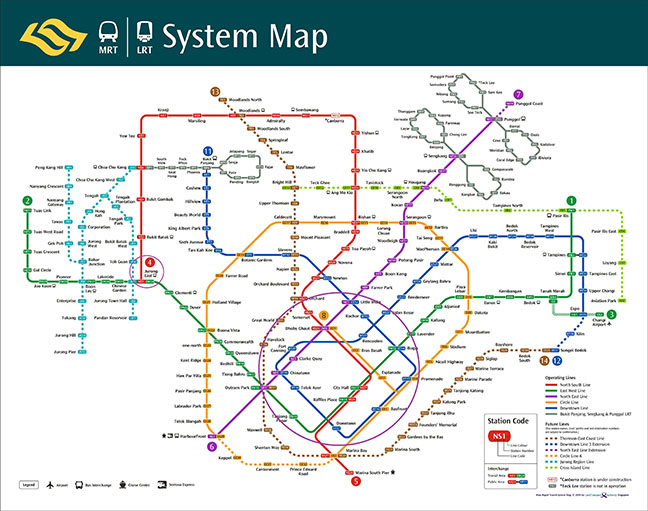
- Hight betweenness centrality, low degree centrality
- We have a graph
Gthat is a barbell graph, which can be created as in the following code cells. m1is the number of nodes in the barbell ends, andm2is the number of nodes in the barbell bridge.- The
keysare the nodes, and thevaluesare thebetweenness centralityscores. - Some values are
0because they’re located at the ends of the barbell graph and the nodes within each end are fully connected with one another. - With the exception of the bridge node and the two nodes it’s connected to, there’s no shortest path that has to run through any of those nodes to get to other nodes.
1
2
G = nx.barbell_graph(m1=5, m2=1)
nx.betweenness_centrality(G)
1
2
3
4
5
6
7
8
9
10
11
{0: 0.0,
1: 0.0,
2: 0.0,
3: 0.0,
4: 0.5333333333333333,
6: 0.5333333333333333,
7: 0.0,
8: 0.0,
9: 0.0,
10: 0.0,
5: 0.5555555555555556}
1
2
nx.draw(G)
plt.show()
NetworkX betweenness centrality on a social network
Betweenness centrality is a node importance metric that uses information about the shortest paths in a network. It is defined as the fraction of all possible shortest paths between any pair of nodes that pass through the node.
NetworkX provides the nx.betweenness_centrality(G) function for computing the betweenness centrality of every node in a graph, and it returns a dictionary where the keys are the nodes and the values are their betweenness centrality measures.
Instructions
- Compute the betweenness centrality
bet_cenof the nodes in the graphT. - Compute the degree centrality
deg_cenof the nodes in the graphT. - Compare betweenness centrality to degree centrality by creating a scatterplot of the two, with
list(bet_cen.values())on the x-axis andlist(deg_cen.values())on the y-axis.
1
2
3
4
5
6
7
8
9
10
11
12
13
# Compute the betweenness centrality of T: bet_cen
bet_cen = nx.betweenness_centrality(t_131)
# Compute the degree centrality of T: deg_cen
deg_cen = nx.degree_centrality(t_131)
# Create a scatter plot of betweenness centrality and degree centrality
plt.scatter(list(bet_cen.values()), list(deg_cen.values()))
# Display the plot
plt.xlim(-0.00005, 0.0002)
plt.xticks(rotation=45)
plt.show()
Deep dive - Twitter network
You’re going to now take a deep dive into a Twitter network, which will help reinforce what you’ve learned earlier. First, you’re going to find the nodes that can broadcast messages very efficiently to lots of people one degree of separation away.
NetworkX has been pre-imported for you as nx.
Instructions
- Write a function
find_nodes_with_highest_deg_cent(G)that returns the node(s) with the highest degree centrality using the following steps: - Compute the degree centrality of
G. - Compute the maximum degree centrality using the
max()function onlist(deg_cent.values()). - Iterate over the degree centrality dictionary,
deg_cent.items(). - If the degree centrality value
vof the current nodekis equal tomax_dc, add it to the set of nodes. - Use your function to find the node(s) that has the highest degree centrality in
T. - Write an assertion statement that checks that the node(s) is/are correctly identified. This has been done for you, so hit ‘Submit Answer’ to see the result!
1
2
3
4
5
6
7
8
9
10
11
12
13
14
15
16
17
18
19
20
21
22
23
24
25
26
27
28
29
# Define find_nodes_with_highest_deg_cent()
def find_nodes_with_highest_deg_cent(G):
# Compute the degree centrality of G: deg_cent
deg_cent = nx.degree_centrality(G)
# Compute the maximum degree centrality: max_dc
max_dc = max(list(deg_cent.values()))
nodes = set()
# Iterate over the degree centrality dictionary
for k, v in deg_cent.items():
# Check if the current value has the maximum degree centrality
if v == max_dc:
# Add the current node to the set of nodes
nodes.add(k)
return nodes
# Find the node(s) that has the highest degree centrality in T: top_dc
top_dc = find_nodes_with_highest_deg_cent(T)
print(f'It looks like node {top_dc} has the highest degree centrality')
# Write the assertion statement
for node in top_dc:
assert nx.degree_centrality(T)[node] == max(nx.degree_centrality(T).values())
1
It looks like node {11824} has the highest degree centrality
Deep dive - Twitter network part II
Next, you’re going to do an analogous deep dive on betweenness centrality! Just a few hints to help you along: remember that betweenness centrality is computed using nx.betweenness_centrality(G).
Instructions
- Write a function
find_node_with_highest_bet_cent(G)that returns the node(s) with the highest betweenness centrality. - Compute the betweenness centrality of
G. - Compute the maximum betweenness centrality using the
max()function onlist(bet_cent.values()). - Iterate over the degree centrality dictionary,
bet_cent.items(). - If the degree centrality value
vof the current nodekis equal tomax_bc, add it to the set of nodes. - Use your function to find the node(s) that has the highest betweenness centrality in
T. - Write an assertion statement that you’ve got the right node. This has been done for you, so hit ‘Submit Answer’ to see the result!
1
2
3
4
5
6
7
8
9
10
11
12
13
14
15
16
17
18
19
20
21
22
23
24
25
26
27
28
29
# Define find_node_with_highest_bet_cent()
def find_node_with_highest_bet_cent(G):
# Compute betweenness centrality: bet_cent
bet_cent = nx.betweenness_centrality(G)
# Compute maximum betweenness centrality: max_bc
max_bc = max(list(bet_cent.values()))
nodes = set()
# Iterate over the betweenness centrality dictionary
for k, v in bet_cent.items():
# Check if the current value has the maximum betweenness centrality
if v == max_bc:
# Add the current node to the set of nodes
nodes.add(k)
return nodes
# Use that function to find the node(s) that has the highest betweenness centrality in the network: top_bc
top_bc = find_node_with_highest_bet_cent(t_131)
print(f'Node {top_bc} has the highest betweenness centrality.')
# Write an assertion statement that checks that the node(s) is/are correctly identified.
for node in top_bc:
assert nx.betweenness_centrality(t_131)[node] == max(nx.betweenness_centrality(t_131).values())
1
Node {3265} has the highest betweenness centrality.
Structures
This chapter is all about finding interesting structures within network data. You’ll learn about essential concepts such as cliques, communities, and subgraphs, which will leverage all of the skills you acquired in Chapter 2. By the end of this chapter, you’ll be ready to apply the concepts you’ve learned to a real-world case study.
Communities & Cliques
- We’re now going to explore the concepts of structures and subgraphs, using NetworkX.
- A lot of this is going to leverage what you’ve learned in the 2nd chapter, particularly on path finding and the use of neighbors.
- Have your ever been in a clique?
- How would you characterize the clique?
- It probably was comprised of people who know everybody else in the group to a pretty strong degree, right?
- Now imagine if there was another new person not originally part of the clique that joined in - now, in this group, it wouldn’t feel like a clique, because the new person doesn’t really know everybody else, and vise versa.
- In network theory, a clique is essentially defined on the social version of a clique:
- A set of nodes that are completely connected by an edge to every other node in the set.
- It is, then, a completely connected graph.
- What might be the simplest clique?
- By the definition of a clique, an edge is the simplest clique possible.
- Now, what would be the simplest complex clique?
- 3 nodes fully connected, a triangle
- What are some applications of finding triangles in a network?
- One example is a friend recommendation system.
- If
AknowsBandAknowsC, butBandCare not yet connected, then there’s a good chance thatBknowsCas well, and may want to be connected online, by doing what we call triangle closures.
Clique Code
- How might you write code that finds all triangles that a node is involved in?
- That will be the exercise that you’re going to go through.
- Suppose you had a graph
G, and you wanted to iterate over every pair of nodes, and not only every edge. - Rather than writing a nested for-loop, you might want to use the combinations function from the Python
itertoolmodule. - In this way, your for-loop can iterate over every pair of nodes in the network, by using the following code
1
t_131
1
<networkx.classes.digraph.DiGraph at 0x2b56e19d510>
1
2
for n in list(combinations(t_131.nodes(), 2))[:10]:
print(n[0], n[1])
1
2
3
4
5
6
7
8
9
10
13829 15372
13829 3086
13829 4111
13829 6163
13829 13334
13829 6168
13829 24
13829 3100
13829 4636
13829 543
Identifying triangle relationships
Now that you’ve learned about cliques, it’s time to try leveraging what you know to find structures in a network. Triangles are what you’ll go for first. We may be interested in triangles because they’re the simplest complex clique. Let’s write a few functions; these exercises will bring you through the fundamental logic behind network algorithms.
In the Twitter network, each node has an 'occupation' label associated with it, in which the Twitter user’s work occupation is divided into celebrity, politician and scientist. One potential application of triangle-finding algorithms is to find out whether users that have similar occupations are more likely to be in a clique with one another.
Instructions
- Import
combinationsfromitertools. - Write a function
is_in_triangle()that has two parameters -Gandn- and checks whether a given node is in a triangle relationship or not. combinations(iterable, n)returns combinations of sizenfromiterable. This will be useful here, as you want combinations of size2fromG.neighbors(n).- To check whether an edge exists between two nodes, use the
.has_edge(node1, node2)method. If an edge exists, then the given node is in a triangle relationship, and you should returnTrue.
1
2
3
4
5
6
7
8
9
10
11
12
13
14
15
16
17
18
19
# Define is_in_triangle()
def is_in_triangle(G, n):
"""
Checks whether a node `n` in graph `G` is in a triangle relationship or not.
Returns a boolean.
"""
in_triangle = False
# Iterate over all possible triangle relationship combinations
for n1, n2 in combinations(G.neighbors(n), 2):
# Check if an edge exists between n1 and n2
if G.has_edge(n1, n2):
in_triangle = True
break
return in_triangle
is_in_triangle(T, 1)
1
True
1
2
3
4
for node in sorted(list(T.nodes())[:60]):
x = is_in_triangle(T, node)
if x == True:
print(f'{node}: {x}')
1
2
3
4
5
6
7
8
9
1: True
16: True
18: True
19: True
28: True
36: True
39: True
43: True
45: True
Finding nodes involved in triangles
NetworkX provides an API for counting the number of triangles that every node is involved in: nx.triangles(G). It returns a dictionary of nodes as the keys and number of triangles as the values. Your job in this exercise is to modify the function defined earlier to extract all of the nodes involved in a triangle relationship with a given node.
Instructions
- Write a function
nodes_in_triangle()that has two parameters -Gandn- and identifies all nodes in a triangle relationship with a given node. - In the
forloop, iterate over all possible triangle relationship combinations. - Check whether the nodes
n1andn2have an edge between them. If they do, add both nodes to the settriangle_nodes. - Use your function in an
assertstatement to check that the number of nodes involved in a triangle relationship with node1of graphTis equal to35.
1
2
3
4
5
6
7
8
9
10
11
12
13
14
15
16
17
18
19
20
21
22
# Write a function that identifies all nodes in a triangle relationship with a given node.
def nodes_in_triangle(G, n):
"""
Returns the nodes in a graph `G` that are involved in a triangle relationship with the node `n`.
"""
triangle_nodes = set([n])
# Iterate over all possible triangle relationship combinations
for n1, n2 in combinations(G.neighbors(n), 2):
# Check if n1 and n2 have an edge between them
if G.has_edge(n1, n2):
# Add n1 to triangle_nodes
triangle_nodes.add(n1)
# Add n2 to triangle_nodes
triangle_nodes.add(n2)
return triangle_nodes
# Write the assertion statement
assert len(nodes_in_triangle(T, 1)) == 23
Finding open triangles
Let us now move on to finding open triangles! Recall that they form the basis of friend recommendation systems; if “A” knows “B” and “A” knows “C”, then it’s probable that “B” also knows “C”.
Instructions
- Write a function
node_in_open_triangle()that has two parameters -Gandn- and identifies whether a node is present in an open triangle with its neighbors. - In the
forloop, iterate over all possible triangle relationship combinations. - If the nodes
n1andn2do not have an edge between them, setin_open_triangletoTrue, break out from theifstatement and returnin_open_triangle. - Use this function to count the number of open triangles that exist in
T. - In the
forloop, iterate over all the nodes inT. - If the current node
nis in an open triangle, incrementnum_open_triangles.
1
2
3
4
5
6
7
8
9
10
11
12
13
14
15
16
17
18
19
20
21
22
23
24
25
26
27
28
29
30
31
32
# Define node_in_open_triangle()
def node_in_open_triangle(G, n):
"""
Checks whether pairs of neighbors of node `n` in graph `G` are in an 'open triangle' relationship with node `n`.
"""
in_open_triangle = False
# Iterate over all possible triangle relationship combinations
for n1, n2 in combinations(G.neighbors(n), 2):
# Check if n1 and n2 do NOT have an edge between them
if not G.has_edge(n1, n2):
in_open_triangle = True
break
return in_open_triangle
# Compute the number of open triangles in T
num_open_triangles = 0
# Iterate over all the nodes in T
for n in T.nodes():
# Check if the current node is in an open triangle
if node_in_open_triangle(T, n):
# Increment num_open_triangles
num_open_triangles += 1
print(f'{num_open_triangles} nodes in graph T are in open triangles.')
1
908 nodes in graph T are in open triangles.
Maximal Cliques
- They are a clique, but that clique can’t be extended by adding another node in the graph.
- For example, the sub-clique of the 3 green nodes can be extended by one blue node to form a large clique.
- As such, these 3 green nodes do not form a maximal clique in the graph.
- The 4 nodes connected as a clique together cannot be extended and still remain a clique, as the remaining node is not fully connected to the other four nodes.
- As such, these four nodes constitute a maximal clique.
Communities
- The concept of maximal cliques has its uses in community finding algorithms.
- Without going into the myriad of details possible, I hope to define, at a basic level, what a community is.
- Cliques form a good starting point for finding communities, as they are fully connected subgraphs within a larger graph.
- By identifying these maximal cliques, one naive way of identifying communities might be identifying the unions of maximal cliques that share some number of members, but are also of some minimum size.
NetworkX API
- NetworkX provides a function for finding all maximal cliques, which is the
find_cliquefunction. - Works for
Graph, but doesn’t work forDiGraph find_cliqeuswill not just find any clique, but the set of maximal cliques.- There are two maximal cliques of size 5 in the graph.
- There are also two maximal cliques of size 2 - these are the edges between nodes
4and5, and nodes5and6. - Recall that edges are also a clique.
1
2
G = nx.barbell_graph(m1=5, m2=1)
nx.find_cliques(G)
1
<generator object find_cliques at 0x000002B56A3617E0>
1
2
3
gl = list(nx.find_cliques(G))
print(gl)
nx.draw(G, with_labels=True)
1
[[4, 0, 1, 2, 3], [4, 5], [6, 5], [6, 7, 8, 9, 10]]
1
2
3
4
G2 = nx.barbell_graph(m1=5, m2=2)
gl2 = list(nx.find_cliques(G2))
print(gl2)
nx.draw(G2, with_labels=True)
1
[[4, 0, 1, 2, 3], [4, 5], [6, 5], [6, 7], [7, 8, 9, 10, 11]]
Finding all maximal cliques of size “n”
Now that you’ve explored triangles (and open triangles), let’s move on to the concept of maximal cliques. Maximal cliques are cliques that cannot be extended by adding an adjacent edge, and are a useful property of the graph when finding communities. NetworkX provides a function that allows you to identify the nodes involved in each maximal clique in a graph: nx.find_cliques(G). Play around with the function by using it on T in the IPython Shell, and then try answering the exercise.
Instructions
- Write a function
maximal_cliques()that has two parameters -Gandsize- and finds all maximal cliques of sizen. - In the
forloop, iterate over all the cliques inGusing thenx.find_cliques()function. - If the current clique is of size
size, append it to the listmcs. - Use an assert statement and your
maximal_cliques()function to check that there are33maximal cliques of size3in the graphT.
1
2
3
4
5
6
7
nodes = {1: {'category': 'I', 'occupation': 'politician'}, 3: {'category': 'D', 'occupation': 'celebrity'}, 4: {'category': 'I', 'occupation': 'politician'}, 5: {'category': 'I', 'occupation': 'scientist'}, 6: {'category': 'D', 'occupation': 'politician'}, 7: {'category': 'I', 'occupation': 'politician'}, 8: {'category': 'I', 'occupation': 'celebrity'}, 9: {'category': 'D', 'occupation': 'scientist'}, 10: {'category': 'D', 'occupation': 'celebrity'}, 11: {'category': 'I', 'occupation': 'celebrity'}, 12: {'category': 'I', 'occupation': 'celebrity'}, 13: {'category': 'P', 'occupation': 'scientist'}, 14: {'category': 'D', 'occupation': 'celebrity'}, 15: {'category': 'P', 'occupation': 'scientist'}, 16: {'category': 'P', 'occupation': 'politician'}, 17: {'category': 'I', 'occupation': 'scientist'}, 18: {'category': 'I', 'occupation': 'celebrity'}, 19: {'category': 'I', 'occupation': 'scientist'}, 20: {'category': 'P', 'occupation': 'scientist'}, 21: {'category': 'I', 'occupation': 'celebrity'}, 22: {'category': 'D', 'occupation': 'scientist'}, 23: {'category': 'D', 'occupation': 'scientist'}, 24: {'category': 'P', 'occupation': 'politician'}, 25: {'category': 'I', 'occupation': 'celebrity'}, 26: {'category': 'P', 'occupation': 'celebrity'}, 27: {'category': 'D', 'occupation': 'scientist'}, 28: {'category': 'P', 'occupation': 'celebrity'}, 29: {'category': 'I', 'occupation': 'celebrity'}, 30: {'category': 'P', 'occupation': 'scientist'}, 31: {'category': 'D', 'occupation': 'scientist'}, 32: {'category': 'P', 'occupation': 'politician'}, 33: {'category': 'I', 'occupation': 'politician'}, 34: {'category': 'D', 'occupation': 'celebrity'}, 35: {'category': 'P', 'occupation': 'scientist'}, 36: {'category': 'D', 'occupation': 'scientist'}, 37: {'category': 'I', 'occupation': 'scientist'}, 38: {'category': 'P', 'occupation': 'celebrity'}, 39: {'category': 'D', 'occupation': 'celebrity'}, 40: {'category': 'I', 'occupation': 'celebrity'}, 41: {'category': 'I', 'occupation': 'celebrity'}, 42: {'category': 'P', 'occupation': 'scientist'}, 43: {'category': 'I', 'occupation': 'celebrity'}, 44: {'category': 'I', 'occupation': 'politician'}, 45: {'category': 'D', 'occupation': 'scientist'}, 46: {'category': 'I', 'occupation': 'politician'}, 47: {'category': 'I', 'occupation': 'celebrity'}, 48: {'category': 'P', 'occupation': 'celebrity'}, 49: {'category': 'P', 'occupation': 'politician'}}
edges = [(1, 3, {'date': date(2012, 11, 16)}), (1, 4, {'date': date(2013, 6, 7)}), (1, 5, {'date': date(2009, 7, 27)}), (1, 6, {'date': date(2014, 12, 18)}), (1, 7, {'date': date(2010, 10, 18)}), (1, 8, {'date': date(2012, 4, 18)}), (1, 9, {'date': date(2007, 10, 14)}), (1, 10, {'date': date(2012, 9, 8)}), (1, 11, {'date': date(2010, 1, 6)}), (1, 12, {'date': date(2012, 12, 27)}), (1, 13, {'date': date(2008, 12, 18)}), (1, 14, {'date': date(2014, 5, 25)}), (1, 15, {'date': date(2009, 11, 12)}), (1, 16, {'date': date(2008, 8, 6)}), (1, 17, {'date': date(2007, 8, 11)}), (1, 18, {'date': date(2009, 10, 7)}), (1, 19, {'date': date(2008, 7, 24)}), (1, 20, {'date': date(2013, 11, 18)}), (1, 21, {'date': date(2011, 3, 28)}), (1, 22, {'date': date(2013, 3, 4)}), (1, 23, {'date': date(2012, 4, 20)}), (1, 24, {'date': date(2009, 6, 6)}), (1, 25, {'date': date(2013, 6, 18)}), (1, 26, {'date': date(2014, 11, 20)}), (1, 27, {'date': date(2007, 4, 28)}), (1, 28, {'date': date(2014, 3, 28)}), (1, 29, {'date': date(2014, 1, 23)}), (1, 30, {'date': date(2007, 10, 9)}), (1, 31, {'date': date(2009, 2, 17)}), (1, 32, {'date': date(2009, 10, 14)}), (1, 33, {'date': date(2010, 5, 19)}), (1, 34, {'date': date(2009, 12, 21)}), (1, 35, {'date': date(2014, 11, 16)}), (1, 36, {'date': date(2010, 2, 25)}), (1, 37, {'date': date(2010, 9, 23)}), (1, 38, {'date': date(2007, 4, 28)}), (1, 39, {'date': date(2007, 4, 8)}), (1, 40, {'date': date(2010, 5, 15)}), (1, 41, {'date': date(2009, 8, 12)}), (1, 42, {'date': date(2013, 3, 9)}), (1, 43, {'date': date(2011, 11, 14)}), (1, 44, {'date': date(2013, 4, 6)}), (1, 45, {'date': date(2010, 1, 18)}), (1, 46, {'date': date(2011, 8, 20)}), (1, 47, {'date': date(2014, 8, 3)}), (1, 48, {'date': date(2010, 3, 15)}), (1, 49, {'date': date(2007, 9, 2)}), (5, 19, {'date': date(2013, 6, 12)}), (5, 28, {'date': date(2010, 12, 4)}), (5, 36, {'date': date(2013, 4, 7)}), (7, 28, {'date': date(2011, 11, 21)}), (8, 19, {'date': date(2010, 11, 5)}), (8, 28, {'date': date(2007, 6, 26)}), (11, 19, {'date': date(2012, 4, 16)}), (11, 28, {'date': date(2011, 6, 21)}), (13, 19, {'date': date(2012, 12, 13)}), (14, 28, {'date': date(2013, 12, 18)}), (15, 19, {'date': date(2008, 12, 13)}), (15, 28, {'date': date(2014, 6, 3)}), (16, 18, {'date': date(2008, 8, 5)}), (16, 35, {'date': date(2014, 6, 4)}), (16, 36, {'date': date(2008, 10, 10)}), (16, 48, {'date': date(2014, 1, 27)}), (17, 19, {'date': date(2007, 11, 11)}), (17, 28, {'date': date(2012, 10, 11)}), (18, 24, {'date': date(2009, 2, 4)}), (18, 35, {'date': date(2008, 12, 1)}), (18, 36, {'date': date(2013, 2, 6)}), (19, 20, {'date': date(2008, 11, 9)}), (19, 21, {'date': date(2007, 7, 23)}), (19, 24, {'date': date(2013, 12, 13)}), (19, 30, {'date': date(2012, 6, 6)}), (19, 31, {'date': date(2011, 1, 27)}), (19, 35, {'date': date(2014, 3, 3)}), (19, 36, {'date': date(2007, 10, 22)}), (19, 37, {'date': date(2008, 4, 20)}), (19, 48, {'date': date(2010, 12, 23)}), (20, 28, {'date': date(2012, 4, 15)}), (21, 28, {'date': date(2014, 4, 27)}), (24, 28, {'date': date(2013, 1, 27)}), (24, 36, {'date': date(2009, 4, 23)}), (24, 37, {'date': date(2008, 6, 27)}), (24, 39, {'date': date(2007, 1, 27)}), (24, 43, {'date': date(2014, 2, 12)}), (25, 28, {'date': date(2014, 5, 9)}), (27, 28, {'date': date(2007, 8, 9)}), (28, 29, {'date': date(2012, 4, 3)}), (28, 30, {'date': date(2007, 12, 2)}), (28, 31, {'date': date(2008, 6, 1)}), (28, 35, {'date': date(2012, 11, 16)}), (28, 36, {'date': date(2012, 9, 26)}), (28, 37, {'date': date(2014, 11, 12)}), (28, 44, {'date': date(2007, 11, 18)}), (28, 48, {'date': date(2008, 5, 25)}), (28, 49, {'date': date(2011, 12, 19)}), (29, 43, {'date': date(2014, 6, 4)}), (33, 39, {'date': date(2011, 9, 5)}), (35, 36, {'date': date(2008, 12, 1)}), (35, 37, {'date': date(2014, 5, 7)}), (35, 39, {'date': date(2007, 6, 17)}), (35, 43, {'date': date(2009, 6, 10)}), (36, 37, {'date': date(2014, 5, 13)}), (36, 39, {'date': date(2014, 12, 6)}), (36, 43, {'date': date(2013, 12, 17)}), (37, 43, {'date': date(2012, 1, 22)}), (38, 39, {'date': date(2009, 5, 15)}), (39, 40, {'date': date(2011, 6, 3)}), (39, 41, {'date': date(2009, 10, 5)}), (39, 45, {'date': date(2011, 1, 12)}), (41, 45, {'date': date(2009, 9, 7)}), (43, 47, {'date': date(2014, 12, 21)}), (43, 48, {'date': date(2013, 1, 28)})]
t_321 = nx.Graph()
t_321.add_nodes_from(nodes)
t_321.add_edges_from(edges)
nx.set_node_attributes(t_321, nodes)
1
2
3
4
5
6
7
8
9
10
11
12
13
# Define maximal_cliques()
def maximal_cliques(G, n):
"""
Finds all maximal cliques in graph `G` that are of size `size`.
"""
mcs = []
for clique in nx.find_cliques(G):
if len(clique) == n:
mcs.append(clique)
return mcs
# Check that there are 33 maximal cliques of size 3 in the graph T
assert len(maximal_cliques(t_321, 3)) == 33
Subgraphs
- When you have a large graph, and you want to visualize just a small portion of it, it can be helpful to extract those nodes and their associated edges as a separate graph object.
- For example, you might want to visualized a particular path through the network, or you might want to visualized a particular community or clique.
- Alternatively, you might just want to explore the structure of the graph around a node out of a number of degrees of separation.
- In all of these scenarios, it’s useful to be able to “slice out” the nodes and edges of interest, and visualize them.
1
2
3
random.seed(121)
G = nx.erdos_renyi_graph(n=20, p=0.2)
G.nodes()
1
NodeView((0, 1, 2, 3, 4, 5, 6, 7, 8, 9, 10, 11, 12, 13, 14, 15, 16, 17, 18, 19))
1
nx.draw(G, with_labels=True)
1
2
nodes = list(G.neighbors(8))
nodes
1
[5, 10, 15, 16, 18]
1
2
3
nodes.append(8)
G_eight = G.subgraph(nodes)
G_eight.edges()
1
EdgeView([(5, 8), (5, 15), (8, 10), (8, 15), (8, 16), (8, 18), (10, 18)])
1
2
display(G_eight)
display(G)
1
2
3
4
5
<networkx.classes.graph.Graph at 0x2b5705e7050>
<networkx.classes.graph.Graph at 0x2b56f7e18d0>
1
nx.draw(G_eight, with_labels=True)
Subgraphs I
There may be times when you just want to analyze a subset of nodes in a network. To do so, you can copy them out into another graph object using G.subgraph(nodes), which returns a new graph object (of the same type as the original graph) that is comprised of the iterable of nodes that was passed in.
matplotlib.pyplot has been imported for you as plt.
Instructions
- Write a function
get_nodes_and_nbrs(G, nodes_of_interest)that extracts the subgraph from graphGcomprised of thenodes_of_interestand their neighbors. - In the first
forloop, iterate overnodes_of_interestand append the current nodentonodes_to_draw. - In the second
forloop, iterate over the neighbors ofn, and append all the neighborsnbrtonodes_to_draw. - Use the function to extract the subgraph from
Tcomprised of nodes 29, 38, and 42 (contained in the pre-defined listnodes_of_interest) and their neighbors. Save the result asT_draw. - Draw the subgraph
T_drawto the screen.
1
2
3
4
5
6
7
8
9
10
11
12
13
14
15
16
17
18
19
20
21
22
23
24
25
26
27
28
29
nodes_of_interest = [29, 38, 42]
# Define get_nodes_and_nbrs()
def get_nodes_and_nbrs(G, nodes_of_interest):
"""
Returns a subgraph of the graph `G` with only the `nodes_of_interest` and their neighbors.
"""
nodes_to_draw = []
# Iterate over the nodes of interest
for n in nodes_of_interest:
# Append the nodes of interest to nodes_to_draw
nodes_to_draw.append(n)
# Iterate over all the neighbors of node n
for nbr in G.neighbors(n):
# Append the neighbors of n to nodes_to_draw
nodes_to_draw.append(nbr)
return G.subgraph(nodes_to_draw)
# Extract the subgraph with the nodes of interest: T_draw
T_draw = get_nodes_and_nbrs(T, nodes_of_interest)
# Draw the subgraph to the screen
nx.draw(T_draw, with_labels=True)
plt.show()
Subgraphs II
In the previous exercise, we gave you a list of nodes whose neighbors we asked you to extract.
Let’s try one more exercise in which you extract nodes that have a particular metadata property and their neighbors. This should hark back to what you’ve learned about using list comprehensions to find nodes. The exercise will also build your capacity to compose functions that you’ve already written before.
Instructions
- Using a list comprehension, extract nodes that have the metadata
'occupation'as'celebrity'alongside their neighbors: - The output expression of the list comprehension is
n, and there are two iterator variables:nandd. The iterable is the list of nodes ofT(including the metadata, which you can specify usingdata=True) and the conditional expression is if the'occupation'key of the metadata dictionarydequals'celebrity'. - Place them in a new subgraph called
T_sub. To do this: - Iterate over the nodes, compute the neighbors of each node, and add them to the set of nodes
nodesetby using the.union()method. This last part has been done for you. - Use
nodesetalong with theT.subgraph()method to calculateT_sub. - Draw
T_subto the screen.
1
2
3
4
5
6
7
8
9
10
11
12
13
14
15
16
17
18
19
20
21
# Extract the nodes of interest: nodes
nodes = [n for n, d in t_321.nodes(data=True) if d['occupation'] == 'celebrity']
# Create the set of nodes: nodeset
nodeset = set(nodes)
# Iterate over nodes
for n in nodes:
# Compute the neighbors of n: nbrs
nbrs = t_321.neighbors(n)
# Compute the union of nodeset and nbrs: nodeset
nodeset = nodeset.union(nbrs)
# Compute the subgraph using nodeset: T_sub
T_sub = t_321.subgraph(nodeset)
# Draw T_sub to the screen
nx.draw(T_sub, with_labels=True)
plt.show()
Bringing it all together
In this final chapter of the course, you’ll consolidate everything you’ve learned through an in-depth case study of GitHub collaborator network data. This is a great example of real-world social network data, and your newly acquired skills will be fully tested. By the end of this chapter, you’ll have developed your very own recommendation system to connect GitHub users who should collaborate together.
Case Study
Data
- This dataset is a GitHub user collaboration network.
- GitHub is a social coding site, where users can collaborate on code repositories.
- In this network, nodes are users, and edges indicate that two users are collaborators on at least one GitHub repository.
- What you’ll be accomplishing by the end of the exercises is the following:
- You will have analyzed the structure of the graph, including its basic properties.
- You will visualize the graph using
nxviz - You will build a simple recommendation system.
- A recommendation system in social networks recommends users to “connect” with one another in some fashion.
- In the GitHub context, we will try writing a recommender that suggests users that should collaborate together.
Graph properties
- Recall from the first chapter about some basic functions for getting a graph’s size.
1
2
3
4
random.seed(121)
G = nx.erdos_renyi_graph(n=20, p=0.2)
print(len(G.edges()))
print(len(G.nodes()))
1
2
45
20
- Are you able to recall what the function names are for computing the degree and betweenness centralities of each node in the graph?
nx.degree_centrality(G)nx.betweenness_centrality(G)- In both cases, the key is the node name and the value is the centrality score
1
2
3
pp(nx.degree_centrality(G))
print('\n')
pp(nx.betweenness_centrality(G))
1
2
3
4
5
6
7
8
9
10
11
12
13
14
15
16
17
18
19
20
21
22
23
24
25
26
27
28
29
30
31
32
33
34
35
36
37
38
39
40
41
42
{0: 0.10526315789473684,
1: 0.3157894736842105,
2: 0.21052631578947367,
3: 0.05263157894736842,
4: 0.2631578947368421,
5: 0.21052631578947367,
6: 0.3157894736842105,
7: 0.15789473684210525,
8: 0.2631578947368421,
9: 0.21052631578947367,
10: 0.3684210526315789,
11: 0.15789473684210525,
12: 0.21052631578947367,
13: 0.2631578947368421,
14: 0.3157894736842105,
15: 0.21052631578947367,
16: 0.21052631578947367,
17: 0.10526315789473684,
18: 0.5263157894736842,
19: 0.2631578947368421}
{0: 0.003759398496240601,
1: 0.08607630186577553,
2: 0.044040657198551936,
3: 0.0,
4: 0.07446393762183234,
5: 0.11647173489278752,
6: 0.08880534670008351,
7: 0.0051239209133945975,
8: 0.11155666945140628,
9: 0.024477861319966585,
10: 0.10698969646338068,
11: 0.01189083820662768,
12: 0.0339459760512392,
13: 0.09337231968810916,
14: 0.05116959064327485,
15: 0.05334168755221386,
16: 0.06688944583681425,
17: 0.0,
18: 0.22528543581175156,
19: 0.02456140350877193}
Characterizing the network (I)
To start out, let’s do some basic characterization of the network, by looking at the number of nodes and number of edges in a network. It has been pre-loaded as G and is available for exploration in the IPython Shell. Your job in this exercise is to identify how many nodes and edges are present in the network. You can use the functions len(G.nodes()) and len(G.edges()) to calculate the number of nodes and edges respectively.
72900 nodes, 56519 edges.- 56519 nodes, 72900 edges.
47095 nodes, 65789 edges.63762 nodes, 71318 edges.
1
2
3
G = nx.Graph(Gh)
print(len(G.nodes()))
print(len(G.edges()))
1
2
56519
72900
Characterizing the network (II)
Let’s continue recalling what you’ve learned before about node importances, by plotting the degree distribution of a network. This is the distribution of node degrees computed across all nodes in a network.
Instructions
- Plot the degree distribution of the GitHub collaboration network
G. Recall that there are four steps involved here: - Calculating the degree centrality of
G. - Using the
.values()method ofGand converting it into a list. - Passing the list of degree distributions to
plt.hist(). - Displaying the histogram with
plt.show().
1
2
3
# Plot the degree distribution of the GitHub collaboration network
plt.hist(list(nx.degree_centrality(G).values()))
plt.show()
Characterizing the network (III)
The last exercise was on degree centrality; this time round, let’s recall betweenness centrality!
A small note: if executed correctly, this exercise may need about 5 seconds to execute.
Instructions
- Plot the betweenness centrality distribution of the GitHub collaboration network. You have to follow exactly the same four steps as in the previous exercise, substituting
nx.betweenness_centrality()in place ofnx.degree_centrality().
1
2
3
4
5
6
7
nodes = {'u41': {'bipartite': 'users', 'grouping': 0}, 'u69': {'bipartite': 'users', 'grouping': 0}, 'u96': {'bipartite': 'users', 'grouping': 0}, 'u156': {'bipartite': 'users', 'grouping': 0}, 'u297': {'bipartite': 'users', 'grouping': 0}, 'u298': {'bipartite': 'users', 'grouping': 0}, 'u315': {'bipartite': 'users', 'grouping': 0}, 'u322': {'bipartite': 'users', 'grouping': 0}, 'u435': {'bipartite': 'users', 'grouping': 0}, 'u440': {'bipartite': 'users', 'grouping': 0}, 'u640': {'bipartite': 'users', 'grouping': 0}, 'u655': {'bipartite': 'users', 'grouping': 0}, 'u698': {'bipartite': 'users', 'grouping': 0}, 'u821': {'bipartite': 'users', 'grouping': 0}, 'u863': {'bipartite': 'users', 'grouping': 0}, 'u901': {'bipartite': 'users', 'grouping': 0}, 'u914': {'bipartite': 'users', 'grouping': 0}, 'u1254': {'bipartite': 'users', 'grouping': 0}, 'u1407': {'bipartite': 'users', 'grouping': 0}, 'u1468': {'bipartite': 'users', 'grouping': 0}, 'u1908': {'bipartite': 'users', 'grouping': 0}, 'u2022': {'bipartite': 'users', 'grouping': 0}, 'u2066': {'bipartite': 'users', 'grouping': 0}, 'u2137': {'bipartite': 'users', 'grouping': 0}, 'u2289': {'bipartite': 'users', 'grouping': 0}, 'u2482': {'bipartite': 'users', 'grouping': 0}, 'u2552': {'bipartite': 'users', 'grouping': 0}, 'u2643': {'bipartite': 'users', 'grouping': 0}, 'u2737': {'bipartite': 'users', 'grouping': 0}, 'u2906': {'bipartite': 'users', 'grouping': 0}, 'u3083': {'bipartite': 'users', 'grouping': 0}, 'u3174': {'bipartite': 'users', 'grouping': 0}, 'u3231': {'bipartite': 'users', 'grouping': 0}, 'u3243': {'bipartite': 'users', 'grouping': 0}, 'u3271': {'bipartite': 'users', 'grouping': 0}, 'u3658': {'bipartite': 'users', 'grouping': 0}, 'u3974': {'bipartite': 'users', 'grouping': 0}, 'u3979': {'bipartite': 'users', 'grouping': 0}, 'u4159': {'bipartite': 'users', 'grouping': 0}, 'u4199': {'bipartite': 'users', 'grouping': 0}, 'u4329': {'bipartite': 'users', 'grouping': 0}, 'u4412': {'bipartite': 'users', 'grouping': 0}, 'u4513': {'bipartite': 'users', 'grouping': 0}, 'u4710': {'bipartite': 'users', 'grouping': 0}, 'u4761': {'bipartite': 'users', 'grouping': 0}, 'u4953': {'bipartite': 'users', 'grouping': 0}, 'u5082': {'bipartite': 'users', 'grouping': 0}, 'u5337': {'bipartite': 'users', 'grouping': 0}, 'u5693': {'bipartite': 'users', 'grouping': 0}, 'u5993': {'bipartite': 'users', 'grouping': 0}, 'u6081': {'bipartite': 'users', 'grouping': 0}, 'u7418': {'bipartite': 'users', 'grouping': 0}, 'u7623': {'bipartite': 'users', 'grouping': 0}, 'u7963': {'bipartite': 'users', 'grouping': 0}, 'u8135': {'bipartite': 'users', 'grouping': 0}, 'u9866': {'bipartite': 'users', 'grouping': 0}, 'u9869': {'bipartite': 'users', 'grouping': 0}, 'u9997': {'bipartite': 'users', 'grouping': 0}, 'u10090': {'bipartite': 'users', 'grouping': 0}, 'u10340': {'bipartite': 'users', 'grouping': 0}, 'u10500': {'bipartite': 'users', 'grouping': 0}, 'u10603': {'bipartite': 'users', 'grouping': 0}, 'u14964': {'bipartite': 'users', 'grouping': 1}}
edges = [('u41', 'u2022', {}), ('u41', 'u69', {}), ('u41', 'u5082', {}), ('u41', 'u298', {}), ('u41', 'u901', {}), ('u69', 'u315', {}), ('u69', 'u4513', {}), ('u69', 'u5082', {}), ('u69', 'u901', {}), ('u69', 'u298', {}), ('u69', 'u2022', {}), ('u96', 'u315', {}), ('u96', 'u2482', {}), ('u96', 'u10500', {}), ('u96', 'u2022', {}), ('u96', 'u863', {}), ('u96', 'u9997', {}), ('u96', 'u297', {}), ('u96', 'u698', {}), ('u96', 'u2066', {}), ('u96', 'u7963', {}), ('u96', 'u156', {}), ('u96', 'u2906', {}), ('u96', 'u2552', {}), ('u156', 'u315', {}), ('u156', 'u2482', {}), ('u156', 'u10500', {}), ('u156', 'u863', {}), ('u156', 'u2022', {}), ('u156', 'u297', {}), ('u156', 'u9997', {}), ('u156', 'u698', {}), ('u156', 'u2066', {}), ('u156', 'u7963', {}), ('u156', 'u2906', {}), ('u156', 'u2552', {}), ('u297', 'u315', {}), ('u297', 'u2482', {}), ('u297', 'u863', {}), ('u297', 'u2022', {}), ('u297', 'u9997', {}), ('u297', 'u698', {}), ('u297', 'u10500', {}), ('u297', 'u2066', {}), ('u297', 'u7963', {}), ('u297', 'u2906', {}), ('u297', 'u2552', {}), ('u298', 'u5082', {}), ('u298', 'u901', {}), ('u298', 'u2022', {}), ('u315', 'u2482', {}), ('u315', 'u10500', {}), ('u315', 'u2022', {}), ('u315', 'u863', {}), ('u315', 'u9997', {}), ('u315', 'u698', {}), ('u315', 'u2066', {}), ('u315', 'u7963', {}), ('u315', 'u2906', {}), ('u315', 'u4513', {}), ('u315', 'u2552', {}), ('u322', 'u3174', {}), ('u322', 'u3974', {}), ('u322', 'u7623', {}), ('u322', 'u8135', {}), ('u322', 'u2022', {}), ('u322', 'u4953', {}), ('u322', 'u640', {}), ('u322', 'u4412', {}), ('u322', 'u10340', {}), ('u322', 'u4159', {}), ('u322', 'u1908', {}), ('u322', 'u3979', {}), ('u322', 'u435', {}), ('u322', 'u821', {}), ('u322', 'u9869', {}), ('u322', 'u9866', {}), ('u322', 'u10603', {}), ('u322', 'u3083', {}), ('u322', 'u4710', {}), ('u435', 'u7623', {}), ('u435', 'u8135', {}), ('u435', 'u2022', {}), ('u435', 'u10603', {}), ('u435', 'u10340', {}), ('u435', 'u9866', {}), ('u440', 'u5693', {}), ('u440', 'u2643', {}), ('u440', 'u10090', {}), ('u440', 'u3271', {}), ('u640', 'u1908', {}), ('u640', 'u3174', {}), ('u640', 'u3979', {}), ('u640', 'u3974', {}), ('u640', 'u821', {}), ('u640', 'u4953', {}), ('u640', 'u4412', {}), ('u640', 'u9869', {}), ('u640', 'u4159', {}), ('u640', 'u4710', {}), ('u640', 'u3083', {}), ('u655', 'u2643', {}), ('u655', 'u2906', {}), ('u655', 'u2137', {}), ('u655', 'u914', {}), ('u655', 'u4513', {}), ('u698', 'u10500', {}), ('u698', 'u2066', {}), ('u698', 'u2906', {}), ('u698', 'u2552', {}), ('u698', 'u9997', {}), ('u698', 'u7963', {}), ('u698', 'u2482', {}), ('u698', 'u863', {}), ('u698', 'u2022', {}), ('u821', 'u3174', {}), ('u821', 'u3974', {}), ('u821', 'u4953', {}), ('u821', 'u4412', {}), ('u821', 'u4159', {}), ('u821', 'u1908', {}), ('u821', 'u3979', {}), ('u821', 'u9869', {}), ('u821', 'u4710', {}), ('u821', 'u3083', {}), ('u863', 'u10500', {}), ('u863', 'u2022', {}), ('u863', 'u7963', {}), ('u863', 'u2906', {}), ('u863', 'u2482', {}), ('u863', 'u9997', {}), ('u863', 'u2552', {}), ('u863', 'u2066', {}), ('u901', 'u2022', {}), ('u901', 'u5082', {}), ('u914', 'u2022', {}), ('u914', 'u3231', {}), ('u1254', 'u2737', {}), ('u1254', 'u2289', {}), ('u1254', 'u2643', {}), ('u1254', 'u4329', {}), ('u1254', 'u4761', {}), ('u1407', 'u2643', {}), ('u1407', 'u6081', {}), ('u1407', 'u3658', {}), ('u1468', 'u5993', {}), ('u1468', 'u2643', {}), ('u1468', 'u2022', {}), ('u1468', 'u7418', {}), ('u1468', 'u5337', {}), ('u1468', 'u9869', {}), ('u1908', 'u3174', {}), ('u1908', 'u3979', {}), ('u1908', 'u3974', {}), ('u1908', 'u4953', {}), ('u1908', 'u4412', {}), ('u1908', 'u9869', {}), ('u1908', 'u4159', {}), ('u1908', 'u4710', {}), ('u1908', 'u3083', {}), ('u2022', 'u2482', {}), ('u2022', 'u5993', {}), ('u2022', 'u7623', {}), ('u2022', 'u8135', {}), ('u2022', 'u10500', {}), ('u2022', 'u10340', {}), ('u2022', 'u9997', {}), ('u2022', 'u3231', {}), ('u2022', 'u2643', {}), ('u2022', 'u2906', {}), ('u2022', 'u5082', {}), ('u2022', 'u4199', {}), ('u2022', 'u9869', {}), ('u2022', 'u2066', {}), ('u2022', 'u9866', {}), ('u2022', 'u7418', {}), ('u2022', 'u7963', {}), ('u2022', 'u5337', {}), ('u2022', 'u10603', {}), ('u2022', 'u2552', {}), ('u2066', 'u10500', {}), ('u2066', 'u7963', {}), ('u2066', 'u2906', {}), ('u2066', 'u2482', {}), ('u2066', 'u9997', {}), ('u2066', 'u2552', {}), ('u2137', 'u2643', {}), ('u2137', 'u4513', {}), ('u2289', 'u4329', {}), ('u2289', 'u4761', {}), ('u2289', 'u2643', {}), ('u2289', 'u2737', {}), ('u2482', 'u10500', {}), ('u2482', 'u7963', {}), ('u2482', 'u2906', {}), ('u2482', 'u9997', {}), ('u2482', 'u2552', {}), ('u2552', 'u10500', {}), ('u2552', 'u9997', {}), ('u2552', 'u2906', {}), ('u2552', 'u7963', {}), ('u2643', 'u10090', {}), ('u2643', 'u5993', {}), ('u2643', 'u5693', {}), ('u2643', 'u4329', {}), ('u2643', 'u4761', {}), ('u2643', 'u9869', {}), ('u2643', 'u6081', {}), ('u2643', 'u2737', {}), ('u2643', 'u3658', {}), ('u2643', 'u3243', {}), ('u2643', 'u7418', {}), ('u2643', 'u5337', {}), ('u2643', 'u4513', {}), ('u2643', 'u3271', {}), ('u2737', 'u4329', {}), ('u2737', 'u4761', {}), ('u2906', 'u10500', {}), ('u2906', 'u9997', {}), ('u2906', 'u7963', {}), ('u3083', 'u3174', {}), ('u3083', 'u3974', {}), ('u3083', 'u4953', {}), ('u3083', 'u4412', {}), ('u3083', 'u4159', {}), ('u3083', 'u3979', {}), ('u3083', 'u9869', {}), ('u3083', 'u4710', {}), ('u3174', 'u3974', {}), ('u3174', 'u4953', {}), ('u3174', 'u4412', {}), ('u3174', 'u4159', {}), ('u3174', 'u3979', {}), ('u3174', 'u9869', {}), ('u3174', 'u4710', {}), ('u3231', 'u4159', {}), ('u3243', 'u3271', {}), ('u3271', 'u10090', {}), ('u3271', 'u5693', {}), ('u3658', 'u6081', {}), ('u3974', 'u4953', {}), ('u3974', 'u4412', {}), ('u3974', 'u4159', {}), ('u3974', 'u3979', {}), ('u3974', 'u9869', {}), ('u3974', 'u4710', {}), ('u3979', 'u4953', {}), ('u3979', 'u4412', {}), ('u3979', 'u4159', {}), ('u3979', 'u9869', {}), ('u3979', 'u4710', {}), ('u4159', 'u4412', {}), ('u4159', 'u9869', {}), ('u4159', 'u4710', {}), ('u4159', 'u4953', {}), ('u4329', 'u4761', {}), ('u4412', 'u4953', {}), ('u4412', 'u9869', {}), ('u4412', 'u4710', {}), ('u4710', 'u4953', {}), ('u4710', 'u9869', {}), ('u4953', 'u9869', {}), ('u5337', 'u5993', {}), ('u5337', 'u7418', {}), ('u5337', 'u9869', {}), ('u5693', 'u10090', {}), ('u5993', 'u7418', {}), ('u5993', 'u9869', {}), ('u7418', 'u9869', {}), ('u7623', 'u8135', {}), ('u7623', 'u10603', {}), ('u7623', 'u10340', {}), ('u7623', 'u9866', {}), ('u7963', 'u10500', {}), ('u7963', 'u9997', {}), ('u8135', 'u10603', {}), ('u8135', 'u10340', {}), ('u8135', 'u9866', {}), ('u9866', 'u10603', {}), ('u9866', 'u10340', {}), ('u9997', 'u10500', {}), ('u10340', 'u10603', {})]
g_413 = nx.Graph()
g_413.add_nodes_from(nodes)
g_413.add_edges_from(edges)
nx.set_node_attributes(g_413, nodes)
1
2
3
# Plot the degree distribution of the GitHub collaboration network
plt.hist(list(nx.betweenness_centrality(g_413).values()))
plt.show()
Case Study: Visualization
- Practicing drawing Circos, Hive and Arc plots
Connected component subgraphs
- The following figure contains two connected component subgraphs
- The one on the left, containing the yellow node, and the one on the right containing the purple node.
- There are no edges connecting the left graph to the right graph.
- A connected component subgraph is a set of nodes connected to one another by some path in the subgraph, and not connected to other nodes in the larger graph.
1
2
3
random.seed(121)
G = nx.erdos_renyi_graph(n=20, p=0.3)
ax = nv.circos(g_413) # node_color_by='key', group_by='key')
1
2
3
random.seed(60)
G = nx.erdos_renyi_graph(n=100, p=0.03)
nx.connected_components(G) # connected_componet_subgraphs() is deprecated
1
<generator object connected_components at 0x000002B56F8D3C40>
1
2
subgraphs = [G.subgraph(c) for c in nx.connected_components(G)]
subgraphs
1
2
3
4
5
[<networkx.classes.graph.Graph at 0x2b573a9ae50>,
<networkx.classes.graph.Graph at 0x2b573b6a550>,
<networkx.classes.graph.Graph at 0x2b57099ced0>,
<networkx.classes.graph.Graph at 0x2b573131d10>,
<networkx.classes.graph.Graph at 0x2b573137f50>]
1
2
3
4
for sg in subgraphs:
print(f'Subgraph has {len(sg.nodes())} nodes')
nx.draw(sg, with_labels=True)
plt.show()
1
Subgraph has 96 nodes
1
Subgraph has 1 nodes
1
Subgraph has 1 nodes
1
Subgraph has 1 nodes
1
Subgraph has 1 nodes
MatrixPlot
Let’s now practice making some visualizations. The first one will be the MatrixPlot. In a MatrixPlot, the matrix is the representation of the edges.
Instructions
- Make a MatrixPlot visualization of the largest connected component subgraph, with authors grouped by their user group number.
- First, calculate the largest connected component subgraph by using the
nx.connected_component_subgraphs(G)inside the providedsorted()function. Python’s built-in sorted() function takes an iterable and returns a sorted list (in ascending order, by default). Therefore, to access the largest connected component subgraph, the statement is sliced with[-1]. - Create the
MatrixPlotobjecth. You have to specify the parametersgraphandnode_groupingto be the largest connected component subgraph and'grouping', respectively. - Draw the
MatrixPlotobject to the screen and display the plot.
1
2
subgraphs = [g_413.subgraph(c) for c in nx.connected_components(g_413)]
subgraphs
1
2
[<networkx.classes.graph.Graph at 0x2b573254790>,
<networkx.classes.graph.Graph at 0x2b572ff6350>]
1
2
3
4
5
# Calculate the largest connected component subgraph: largest_ccs
largest_ccs = sorted(subgraphs, key=lambda x: len(x))[-1]
# Create the customized MatrixPlot object: h
ax = nv.matrix(largest_ccs, group_by='grouping', )
Recall that in a MatrixPlot, nodes are the rows and columns of the matrix, and cells are filled in according to whether an edge exists between the pairs of nodes.
1
2
3
plt.figure(figsize=(10, 10))
nx.draw(largest_ccs, with_labels=True)
plt.show()
ArcPlot
Next up, let’s use the ArcPlot to visualize the network. You’re going to practice sorting the nodes in the graph as well.
Note: this exercise may take about 4-7 seconds to execute if done correctly.
Instructions
- Make an ArcPlot of the GitHub collaboration network, with authors sorted by degree. To do this:
- Iterate over all the nodes in
G, including the metadata (by specifyingdata=True). - In each iteration of the loop, calculate the degree of each node
nwithnx.degree()and set its'degree'attribute.nx.degree()accepts two arguments: A graph and a node. - Create the
ArcPlotobjectaby specifying two parameters: thegraph, which isG, and thenode_order, which is'degree', so that the nodes are sorted. - Draw the
ArcPlotobject to the screen.
1
2
3
4
5
6
7
8
9
# Iterate over all the nodes in G, including the metadata
for n, d in g_413.nodes(data=True):
# Calculate the degree of each node: G.node[n]['degree']
g_413.nodes[n]['degree'] = nx.degree(g_413, n)
# Create the ArcPlot object: a
plt.figure(figsize=(10, 10))
ax = nv.arc(g_413, sort_by='degree', group_by='grouping', node_color_by='grouping')
CircosPlot
Finally, you’re going to make a CircosPlot of the network!
Instructions
- Make a CircosPlot of the network, again, with GitHub users sorted by their degree, and grouped and
colouredby their ‘grouping’ key. To do this: - Iterate over all the nodes in
G, including the metadata (by specifyingdata=True). - In each iteration of the loop, calculate the degree of each node
nwithnx.degree()and set its'degree'attribute. - Create the
CircosPlotobjectcby specifying three parameters in addition to the graphG: thenode_order, which is'degree', thenode_groupingand thenode_color, which are both'grouping'. - Draw the
CircosPlotobject to the screen.
1
2
3
4
5
6
7
8
9
# Iterate over all the nodes in G, including the metadata
for n, d in g_413.nodes(data=True):
# Calculate the degree of each node: G.node[n]['degree']
g_413.nodes[n]['degree'] = nx.degree(g_413, n)
# Create the ArcPlot object: a
plt.figure(figsize=(10, 10))
a = nv.circos(g_413, sort_by='degree', group_by='grouping', node_color_by='grouping')
This CircosPlot provides a compact alternative to the ArcPlot. It is easy to see in this plot that most users belong to one group.
Case Study: Cliques
- A group of nodes that are fully connected to one another.
- The simplest clique is an edge and the simplest “complex” clique is a triangle.
- A maximal clique is a clique that cannot be extended by adding another node in the graph.
1
2
3
4
5
G = nx.erdos_renyi_graph(n=100, p=0.15)
print(nx.find_cliques(G))
clique_lens = Counter([len(clique) for clique in nx.find_cliques(G)])
clique_lens
1
2
3
4
5
6
7
<generator object find_cliques at 0x000002B56A361930>
Counter({3: 374, 2: 80, 4: 40})
Finding cliques (I)
You’re now going to practice finding cliques in G. Recall that cliques are “groups of nodes that are fully connected to one another”, while a maximal clique is a clique that cannot be extended by adding another node in the graph.
Instructions
- Count the number of maximal cliques present in the graph and print it.
- Use the
nx.find_cliques()function ofGto find the maximal cliques. - The
nx.find_cliques()function returns a generator object. To count the number of maximal cliques, you need to first convert it to a list withlist()and then use thelen()function. Place this inside aprint()function to print it.
1
2
3
cliques = sorted([len(cl) for cl in nx.find_cliques(g_413)], reverse=True)
print(cliques)
print(f'There are {len(cliques)} cliques.')
1
2
[14, 13, 8, 7, 6, 6, 5, 4, 4, 3, 3, 3, 3, 3, 2, 2, 2, 2, 1]
There are 19 cliques.
Finding cliques (II)
Let’s continue by finding a particular maximal clique, and then plotting that clique.
Instructions
- Find the author(s) that are part of the largest maximal clique, and plot the subgraph of that/one of those clique(s) using a CircosPlot. To do this:
- Use the
nx.find_cliques()function to calculate the maximal cliques inG. Place this within the providedsorted()function to calculate the largest maximal clique. - Create the subgraph consisting of the largest maximal clique using the
.subgraph()method andlargest_clique. - Create the
CircosPlotobject using the subgraphG_lc(without any other arguments) and plot it.
1
2
3
4
5
6
7
8
9
10
# Find the author(s) that are part of the largest maximal clique: largest_clique
largest_clique = sorted(nx.find_cliques(g_413), key=lambda x:len(x))[-1]
# Create the subgraph of the largest_clique: G_lc
G_lc = g_413.subgraph(largest_clique)
for n, d in G_lc.nodes(data=True):
# add the node as a key - value pair in the data, so the key can be used to annotate in the new API
G_lc.nodes[n]['node'] = n
print(n, d)
1
2
3
4
5
6
7
8
9
10
11
12
13
14
u2022 {'bipartite': 'users', 'grouping': 0, 'degree': 34, 'node': 'u2022'}
u2906 {'bipartite': 'users', 'grouping': 0, 'degree': 14, 'node': 'u2906'}
u156 {'bipartite': 'users', 'grouping': 0, 'degree': 13, 'node': 'u156'}
u10500 {'bipartite': 'users', 'grouping': 0, 'degree': 13, 'node': 'u10500'}
u698 {'bipartite': 'users', 'grouping': 0, 'degree': 13, 'node': 'u698'}
u9997 {'bipartite': 'users', 'grouping': 0, 'degree': 13, 'node': 'u9997'}
u2482 {'bipartite': 'users', 'grouping': 0, 'degree': 13, 'node': 'u2482'}
u7963 {'bipartite': 'users', 'grouping': 0, 'degree': 13, 'node': 'u7963'}
u863 {'bipartite': 'users', 'grouping': 0, 'degree': 13, 'node': 'u863'}
u2066 {'bipartite': 'users', 'grouping': 0, 'degree': 13, 'node': 'u2066'}
u96 {'bipartite': 'users', 'grouping': 0, 'degree': 13, 'node': 'u96'}
u297 {'bipartite': 'users', 'grouping': 0, 'degree': 13, 'node': 'u297'}
u315 {'bipartite': 'users', 'grouping': 0, 'degree': 15, 'node': 'u315'}
u2552 {'bipartite': 'users', 'grouping': 0, 'degree': 13, 'node': 'u2552'}
1
2
3
4
5
6
7
# Create the CircosPlot object: c
plt.figure(figsize=(10, 10))
c = nv.circos(G_lc)
annotate.circos_group(G_lc, group_by='node', radius_offset=1, midpoint=False)
# Draw the CircosPlot to the screen
print(f'The largest maximal clique consists of {len(largest_clique)} users')
1
The largest maximal clique consists of 14 users
Case Study: Final Tasks
- Find important GitHub users based on their collaborative relationships
- Look for GitHub users that share collaborations with the most number of other users.
- degree centrality
- Find the largest communities of collaborators.
- You’ll be looking for the largest communities of collaborators.
- maximal clique
- Guild a recommendation system for GitHub users based on the concept of open triangles.
- open triangles: I’m connected to two people who are not connected to one another
Finding important collaborators
You’ll now look at important nodes once more. Here, you’ll make use of the degree_centrality() and betweenness_centrality() functions in NetworkX to compute each of the respective centrality scores, and then use that information to find the “important nodes”. In other words, your job in this exercise is to find the user(s) that have collaborated with the most number of users.
Instructions
- Compute the degree centralities of
G. Store the result asdeg_cent. - Compute the maximum degree centrality. Since
deg_centis a dictionary, you’ll have to use the.values()method to get a list of its values before computing the maximum degree centrality withmax(). - Identify the most prolific collaborators using a list comprehension:
- Iterate over the degree centrality dictionary
deg_centthat was computed earlier using its.items()method. What condition should be satisfied if you are seeking to find user(s) that have collaborated with the most number of users? Hint: It has do to with the maximum degree centrality. - Hit ‘Submit Answer’ to see who the most prolific collaborator(s) is/are!
1
2
3
4
5
6
7
8
9
10
11
12
13
14
# Compute the degree centralities of G: deg_cent
deg_cent = nx.degree_centrality(g_413)
# Sorting the dictionary
deg_cent = {k: v for k, v in sorted(deg_cent.items(), key=lambda item: item[1], reverse=True)}
# Compute the maximum degree centrality: max_dc
max_dc = max(list(deg_cent.values()))
# Find the user(s) that have collaborated the most: prolific_collaborators
prolific_collaborators = [n for n, dc in deg_cent.items() if dc == max_dc]
# Print the most prolific collaborator(s)
print(f'The most prolific collaborator(s): {prolific_collaborators}')
1
The most prolific collaborator(s): ['u2022']
1
max_dc
1
0.5483870967741935
1
deg_cent
1
2
3
4
5
6
7
8
9
10
11
12
13
14
15
16
17
18
19
20
21
22
23
24
25
26
27
28
29
30
31
32
33
34
35
36
37
38
39
40
41
42
43
44
45
46
47
48
49
50
51
52
53
54
55
56
57
58
59
60
61
62
63
{'u2022': 0.5483870967741935,
'u2643': 0.3548387096774194,
'u322': 0.3064516129032258,
'u9869': 0.29032258064516125,
'u315': 0.24193548387096775,
'u2906': 0.22580645161290322,
'u96': 0.2096774193548387,
'u156': 0.2096774193548387,
'u297': 0.2096774193548387,
'u698': 0.2096774193548387,
'u863': 0.2096774193548387,
'u2066': 0.2096774193548387,
'u2482': 0.2096774193548387,
'u2552': 0.2096774193548387,
'u4159': 0.2096774193548387,
'u7963': 0.2096774193548387,
'u9997': 0.2096774193548387,
'u10500': 0.2096774193548387,
'u640': 0.1935483870967742,
'u821': 0.1935483870967742,
'u1908': 0.1935483870967742,
'u3083': 0.1935483870967742,
'u3174': 0.1935483870967742,
'u3974': 0.1935483870967742,
'u3979': 0.1935483870967742,
'u4412': 0.1935483870967742,
'u4710': 0.1935483870967742,
'u4953': 0.1935483870967742,
'u69': 0.11290322580645161,
'u435': 0.11290322580645161,
'u7623': 0.11290322580645161,
'u8135': 0.11290322580645161,
'u9866': 0.11290322580645161,
'u10340': 0.11290322580645161,
'u10603': 0.11290322580645161,
'u1468': 0.0967741935483871,
'u5337': 0.0967741935483871,
'u5993': 0.0967741935483871,
'u7418': 0.0967741935483871,
'u41': 0.08064516129032258,
'u298': 0.08064516129032258,
'u655': 0.08064516129032258,
'u901': 0.08064516129032258,
'u1254': 0.08064516129032258,
'u2289': 0.08064516129032258,
'u2737': 0.08064516129032258,
'u3271': 0.08064516129032258,
'u4329': 0.08064516129032258,
'u4513': 0.08064516129032258,
'u4761': 0.08064516129032258,
'u5082': 0.08064516129032258,
'u440': 0.06451612903225806,
'u5693': 0.06451612903225806,
'u10090': 0.06451612903225806,
'u914': 0.04838709677419355,
'u1407': 0.04838709677419355,
'u2137': 0.04838709677419355,
'u3231': 0.04838709677419355,
'u3658': 0.04838709677419355,
'u6081': 0.04838709677419355,
'u3243': 0.03225806451612903,
'u4199': 0.016129032258064516,
'u14964': 0.0}
Characterizing editing communities
You’re now going to combine what you’ve learned about the BFS algorithm and concept of maximal cliques to visualize the network with an ArcPlot.
The largest maximal clique in the Github user collaboration network has been assigned to the subgraph G_lmc. Note that for NetworkX version 2.x and later, G.subgraph(nodelist) returns only an immutable view on the original graph. We must explicitly ask for a .copy() of the graph to obtain a mutatable version.
Instructions
- Go out 1 degree of separation from the clique, and add those users to the subgraph. Inside the first
forloop: - Add nodes to
G_lmcfrom the neighbors ofGusing the.add_nodes_from()and.neighbors()methods. - Using the
.add_edges_from(), method, add edges toG_lmcbetween the current node and all its neighbors. To do this, you’ll have create a list of tuples using thezip()function consisting of the current node and each of its neighbors. The first argument tozip()should be[node]*len(list(G.neighbors(node))), and the second argument should be the neighbors ofnode. - Record each node’s degree centrality score in its node metadata.
- Do this by assigning
nx.degree_centrality(G_lmc)[n]toG_lmc.node[n]['degree centrality']in the secondforloop. - Visualize this network with an ArcPlot sorting the nodes by degree centrality (you can do this using the keyword argument
node_order='degree centrality').
1
2
3
4
5
6
7
8
9
10
11
12
13
14
15
16
17
18
19
# Identify the largest maximal clique: largest_max_clique
largest_max_clique = set(sorted(nx.find_cliques(g_413), key=lambda x: len(x))[-1])
print(largest_max_clique)
# Create a subgraph from the largest_max_clique: G_lmc
G_lmc = g_413.subgraph(largest_max_clique).copy()
display(G_lmc)
# Go out 1 degree of separation
for node in list(G_lmc.nodes()):
G_lmc.add_nodes_from(g_413.neighbors(node))
G_lmc.add_edges_from(zip([node]*len(list(g_413.neighbors(node))), g_413.neighbors(node)))
# Record each node's degree centrality score
for n in G_lmc.nodes():
G_lmc.nodes[n]['degree centrality'] = nx.degree_centrality(G_lmc)[n]
# Create the ArcPlot object: a
a = nv.arc(G_lmc, sort_by='degree centrality')
1
2
3
4
5
{'u2022', 'u2906', 'u156', 'u10500', 'u698', 'u9997', 'u2482', 'u7963', 'u863', 'u2066', 'u96', 'u297', 'u315', 'u2552'}
<networkx.classes.graph.Graph at 0x2b5704b7790>
Recommending co-editors who have yet to edit together
Finally, you’re going to leverage the concept of open triangles to recommend users on GitHub to collaborate!
Instructions
- Compile a list of GitHub users that should be recommended to collaborate with one another. To do this:
- In the first
forloop, iterate over all the nodes inG, including the metadata (by specifyingdata=True). - In the second
forloop, iterate over all the possible trianglecombinations, which can be identified using the combinations() function with asizeof2. - If
n1andn2do not have an edge between them, a collaboration between these two nodes (users) should be recommended, so increment the(n1), (n2)value of therecommendeddictionary in this case. You can check whether or notn1andn2have an edge between them using the.has_edge()method. - Using a list comprehension, identify the top 10 pairs of users that should be recommended to collaborate. The iterable should be the key-value pairs of the
recommendeddictionary (which can be accessed with the.items()method), while the conditional should be satisfied ifcountis greater than the top 10 inall_counts. Note thatall_countsis sorted in ascending order, so you can access the top 10 withall_counts[-10].
1
G = nx.Graph(Gh)
1
2
3
4
5
6
7
8
9
10
11
12
13
14
15
16
17
18
19
# Initialize the defaultdict: recommended
recommended = defaultdict(int)
# Iterate over all the nodes in G
for n, d in g_413.nodes(data=True):
# Iterate over all possible triangle relationship combinations
for n1, n2 in combinations(g_413.neighbors(n), 2):
# Check whether n1 and n2 do not have an edge
if not g_413.has_edge(n1, n2):
# Increment recommended
recommended[((n1), (n2))] += 1
# Identify the top 10 pairs of users
all_counts = sorted(recommended.values())
top10_pairs = [pair for pair, count in recommended.items() if count > all_counts[-10]]
print(f'Pairs of users who should collaborate: {top10_pairs}')
1
Pairs of users who should collaborate: [('u2022', 'u4159'), ('u655', 'u2022')]
1
2
3
plt.figure(figsize=(15, 15))
nx.draw(g_413, with_labels=True)
plt.show()
What You’ve Learned
- The basics of networks and network analysis
- How to find important nodes
- How to identify communities of nodes
- How to apply these concepts in case studies
- How to use the NetworkX and nxviz packages to model, analyze and visualized network data.
- How to write algorithms that operate on networks to do useful things like finding paths.
- You’ve seen practical application of network analysis, and even tried your hand at implementing them.
